Preparing Future Science Teachers to Build a Sustainable World: Supporting Pre-Service Science Teachers’ Competencies in Instructional Planning for Teaching the Sustainable Development Goals (SDGs) in K-12 Classrooms
Abstract
1. Introduction
- How can pre-service science teachers’ (PSTs) competencies in instructional planning for teaching Sustainable Development Goals (SDGs) in K-12 classrooms be developed through Education for Sustainable Development Goals (ESDG)?
2. Research Framework
2.1. Education for Building a Sustainable Future
2.2. Teachers’ Competencies for Teaching Sustainable Development Goals (SDGs)
3. Method
3.1. Design
3.2. Research Group
3.3. Intervention
3.4. Data Collection
3.5. Data Analysis
4. Results
4.1. Results for Pre-Service Science Teachers’ Competencies in Instructional Planning for SDG 1
PST 3: I heard the SDG 1: No poverty, but I have no idea about how I can teach in class because we don’t have any course about this.(Pre) (Poor).
PST 3: Thanks to what I learned in this course, I can design lesson plan for ‘No poverty’ using 5E instructional model. As a teacher, I define my learning objectives firstly. These objectives can be like: ‘students can explain the effects and consequences of poverty worldwide, they can demonstrate sensitivity to poverty problems and demonstrate empathy and solidarity with poor and vulnerable people and they can plan, implement, evaluate, and replicate activities that will contribute to poverty reduction’. Then, at engage part, I started the lesson by showing videos to students (e.g., Would you stop if you saw this little girl on the street? https://www.youtube.com/watch?v=MQcN5DtMT-0&t=7s (accessed on 10 September 2025). After watching the video, I will initiate a short discussion with the students, asking them how watching the video made them feel and the reasons of people’ reactions. At explore part, I make students do activity whose purpose is to clarify that poverty is a dynamic concept that can affect anyone at any point in their life (e.g., Mary and David are on their way to school. On their way, they see a man in shabby clothes and poor condition selling water). Based on this activity, I try to help students identify the connections between poverty, education, livelihoods, and access to healthcare, and understand that poverty is a dynamic concept that evolves over time due to life’s circumstances. At explain part, linking to the role-play suggested at explore part, where students directly experience poverty and vulnerability, I can explain to them how the public system establishes social assistance through social services. At elaborate part, students will be divided into groups of four or five, and each group will manage 100,000,000 Turkish Liras. Students are asked to imagine themselves on the district’s administrative council. They are tasked with dividing the budget among different social assistance areas (How would you allocate the budget to prevent poverty and create a more just, equitable, and compassionate society?) Students are asked to find a formula that the entire group would agree on for managing the amount of money in the budget lines. Once the agreement is reached, it will be presented to other students and the criteria and justifications used in management will be explained. At evaluation part, students will be asked to choose a day when they will help people they encounter on the street. If they can take a photo, they will be asked to present it to their classmates in the next class.(Post) (Good).
4.2. Results for Pre-Service Science Teachers’ Competencies in Instructional Planning for SDG 2
PST 8: Maybe I can explain what hunger is and I can show some pictures about hungry people around the world. I don’t know what else to do.(Post) (Good).
PST 8: I can design lesson plan for ‘Zero hunger’ using 5E instructional model. As a teacher, I can define my learning objective firstly. The objectives can be like: students can explain what hunger is and its impact on the world, explain the negative effects of hunger and malnutrition on people’s health, and they can explain how injustices in food production and distribution contribute to the problem of hunger, they can discuss the contributions that individuals can make to ending hunger (such as preventing food waste, conscious consumption). Then, at engage part, as a teacher, I state how many people worldwide go to bed hungry every night. I want students to discuss this number in class. Then, I mention the United Nations’ Zero Hunger initiative. I ask for a connection between the two (the number and initiative). Then, I play videos about hunger (https://www.youtube.com/watch?v=ifCQ4LqT8G8) (accessed on 10 September 2025). After watching the video, I want the class to analyze it and then ask two questions. I divide the class into two groups for discussion. One group discuss the question of “In which regions of the world is hunger most prevalent? What are its causes? (Natural disasters, wars, poverty, etc.)”. Other group discuss the question of “What is food waste? How does food waste affect hunger?” After the discussions, at explain part, I ask the class guiding questions (“What causes hunger?” and “How can we reduce food waste?”) Then, I provide detailed information about SDG 2, Zero Hunger. At elaborate part, students are asked to discuss the following question: “What can we do to end hunger?” Then, students are divided into three groups voluntarily. One group are asked to imagine a person experiencing hunger in Africa, other group in the United States, and another group in Türkiye. They are asked to write a letter to a friend living in another country. First, the entire class is introduced to these countries and regions, and they are expected to write accordingly. Students read their writings in class and participate in class discussions. At evaluate part, as a teacher, I evaluate students by asking them the following questions like “What are the root causes of hunger?” ”What steps can be taken to end hunger?” Brief feedback is given based on students’ answers, and the achievement of the lesson’s objectives is monitored.(Post) (Good).
4.3. Results for Pre-Service Science Teachers’ Competencies in Instructional Planning for SDG 3
PST 11: I don’t know. I think that I have no knowledge about teaching SDG 3.(Pre) (Poor).
PST 11: I can design lesson plan for ‘Good health and well-being’. As a teacher, I define my learning objective firstly. The objectives can be like: students explain that they are a part of the environment they live in and they associate healthy living with the environment within the scope of the Sustainable Development Goals. Students are asked the questions, “What kind of interaction is there between humans and nature? How does it affect our health and how we live a sustainable, quality life?” and the topic is expanded upon based on the answers they receive. Students give examples of the interaction between nature and humans. They consider their contributions to human health and the goal of sustainable development, which is the quality of life.(Post) (Poor).
4.4. Results for Pre-Service Science Teachers’ Competencies in Instructional Planning for SDG 4
PST 15: I define my learning objectives and I mention the characteristics of quality education and the effects of quality education on society.(Pre) (Poor).
PST 15: I can design lesson plan for “Quality Education” using 5E instructional model. As a teacher, I define my learning objective firstly. These objectives are like: students recognize the positive effects of quality education on individual development, explain the importance of equality and opportunity in accessing education and discuss lifelong learning. At engage part, I ask students, “What is quality education? What kind of education would you consider more quality?” to capture students’ attention and spark curiosity about the topic. They watch a video explaining the educational approach of a leading country in the world. Then, I ask the question: “What do you think is most important in education? What would it be like to receive a quality education?” At explore part, students are divided into small groups, and each group acts out a scenario related to “quality education.” The scenarios could be (1) a classroom with good teachers, (2) a school rich in resources and materials and (3) a classroom where students actively participate and technology is used effectively. Students dramatize these scenarios (by using board, books, projector, etc.) for 3–4 min and discover what quality education looks like. I ask the “From the situations you simulated, could you understand what quality education is? What was the most effective element?” to enable students to explore the different components of quality education through drama. At explain part, the subject is conveyed to the students through presentation by me, as a teacher. At elaborate part, students watch a short video about different education systems. The video shows schools in different countries and the quality of education in these schools. Based on the video, students will discuss which countries are better in terms of quality education and why. Then, teacher asks “Which education systems offer quality education? Based on the videos you watched, how would you define a school that offers quality education?” Therefore, students deepen the knowledge they gain from drama activity and connect it to the real world. At evaluate part, the class is divided into two groups. One group writes about the factors that contribute to poor quality education, while the other writes about what needs to be done to achieve quality education. These are shared with the class to evaluate and reinforce what students have learned.(Post) (Good).
4.5. Results for Pre-Service Science Teachers’ Competencies in Instructional Planning for SDG 5
PST 2: I think it is difficult to teach. I mention what gender equality is but I don’t know how to explain it in all aspects. I think we should get education about teaching these issues.(Post) (Good).
PST 2: I can design lesson plan for ‘Gender equality’ using 5E instructional model. As a teacher, I define my learning objective firstly. The objectives can be: students recognize the concept of gender equality, explore social problems on this issue, and develop solutions. At engage part, a short video or animation is shown (for example, a video explaining the importance of gender equality: https://www.youtube.com/watch?v=XaXuRWAt03g) (accessed on 10 September 2025). Then, I ask the question: “What did you understand from this video? What does gender equality mean to you?” Students discusses the responses to these questions. At explore part, students are divided into small groups. Each group is assigned a topic related to gender inequality (e.g., education, work, family roles). Therefore, I encourage students to explore the topic from different perspectives. Each group discusses the inequalities and their causes on the assigned topic. Moreover, the groups will prepare a short presentation on the topic. At explain part, each group presents their prepared presentation to the other groups. During the presentation, they focus on the causes and consequences of gender inequality. The teacher clarifies the topic. At elaborate part, students perform a drama activity prepared by the teacher. The subject of the drama is the stereotyped roles of women and men in family. Then, at evaluate part, students are asked to write a reflective essay about the course. They are encouraged to reflect by asking questions such as, “What does gender equality mean to me?”(Post) (Good).
4.6. Results for Pre-Service Science Teachers’ Competencies in Instructional Planning for SDG 6
PST 18: I mention the importance of clean water and sanitation for our health in my lesson. I show students a video including not polluting and protecting our waters.(Pre) (Poor).
PST 18: I can design lesson plan for ‘Clean water and sanitation’ using 5E instructional model. As a teacher, I define my learning objective firstly. In line with these objectives at engage part, in order to engage students and raise awareness of the importance of water, I pose a question to the class: “How would your life change if you never had access to clean water?” Then, using a short video or visual, I present the global importance of water and examples from water-scarce regions. The students are asked the following questions: (“What would animals, plants, and people do without clean water?” “Where do you use water the most?”) At explore part, in order to enable students to explore the different uses of water and the effects of water shortages, I divide students into groups and want them to search the different uses of water such as, water use in the home, water in agriculture, water in industry, water in the natural world, water in tourism and commerce. Each group will conduct a brief brainstorming session and prepare a poster explaining why water is important in that area. At explain part, as a teacher, I explain, in simple language, the water cycle and the limited availability of clean water resources to explain the importance of water from a scientific and social perspective, using different situations. In addition, I give students examples of water problems around the world (e.g., migratory birds losing their habitats due to drying up of water sources, declines in agricultural production, diseases caused by polluted water, tourism’s dependence on water resources). At elaborate part, I help students understand the importance of water by building empathy through a drama activity. The drama activity can be “Stories of Water”. Five students are selected voluntarily to play the following roles: (o Migratory Bird: A bird facing difficulties on its migration route because water sources have dried up, o Farmer: A farmer unable to irrigate and grow crops, o Sick Child: A child suffering from diarrhea due to drinking polluted water, o Fisherman: A fisherman unable to fish in polluted water sources, o Tourist: A business owner who has lost tourist interest due to polluted water). Each character comes on stage and tells their own story (during 2–3 min). Other students listen carefully and take notes on the stories. At evaluate part, teacher evaluates what students have learned through drama and discussion. Each group develops solutions to the problems experienced by a character. And they present their solutions to the class with a presentation or poster.(Post) (Good).
4.7. Results for Pre-Service Science Teachers’ Competencies in Instructional Planning for SDG 7
PST 9: As a teacher, I teach renewable and nonrenewable energies and the advantages of using renewable energy. I try to design the course so that students can discuss about types of energy.(Pre) (Poor).
PST 9: I can design lesson plan for ‘Affordable and clean energy’ using 5E instructional model. As a teacher, I define my learning objective like: students explain that fossil fuels are limited and one of the non-renewable energy sources, and the importance of renewable energy sources by giving examples. At engage part, I ask students to understand what they know about energy sources and whether they know the difference between renewable and non-renewable. The concept of “sustainability” is discussed and whether they have heard of it. Visuals of various energy sources (coal, oil, wind, solar, hydroelectric, etc.) are shown in class. Students’ opinions are sought by asking questions like “Which is environmentally friendly?” and “Which is exhaustible?” I play the video to students (e.g., https://youtu.be/Bybtrp3fXJw?si=ZAFLxOlWvk4Gyjf8) (accessed on 10 September 2025). At explore part, students are given different scenarios to develop ideas about how renewable energy sources can be used in different scenarios (island country, polluted city, farm, forest village), and they are expected to propose solutions. At explain part, more in-depth information is provided about renewable energy sources by me, as a teacher. The general characteristics of renewable energy sources are explained. The workings, advantages, and applications of solar energy, wind energy, hydroelectric energy, biomass energy, and geothermal energy are explained. Furthermore, the environmental impacts of these sources and sustainability issues are discussed by students. At elaborate part, students are asked to develop a solution proposal for which renewable energy source would be most suitable to meet their community’s energy needs. In presenting this solution, they are expected to explain the advantages and disadvantages of each source, as well as its environmental impact. Students share their solutions with the class and exchange ideas with other students. At evaluate part, a short quiz consisting of 5–6 questions about renewable, affordable and clean energy sources is given. This quiz includes questions such as what each source is, how it works, and its advantages/disadvantages.(Post) (Good).
4.8. Results for Pre-Service Science Teachers’ Competencies in Instructional Planning for SDG 8
PST 20: To be honest, I do not have enough knowledge about decent work and economic growth, so I don’t think that I can do an effective teaching. Of course, I know the terms decent work and economic growth but I don’t know what to teach students about this themes because they are so young and I’m not sure that they can understand this.(Pre) (Poor).
PST 20: I can design lesson plan for ‘decent work and economic growth’. I use 5E instructional model because this method can be effective. As a teacher, firstly, I define my learning objective like: students state the aims and importance of supporting uninterrupted, inclusive, and sustainable economic growth, full and productive employment, and decent work for all. In addition, students discuss the current situation in Türkiye and the world on this issue. At engage part, in order to engage students’ interest in the topic and establish connections to daily life, a short video (https://youtu.be/A9OTEOtfnWc?si=A2BdCjUWPJxErdjS) (accessed on 10 September 2025) or image is shown on the poverty and unemployment data mentioned in the presentation. Students are asked short questions about the poverty line, the effects of unemployment, and the global situation mentioned in the presentation to gather their opinions. At explore part, as a teacher, I enable students to explore concepts through their own observations and research. Therefore, students are divided into groups. Each group is given topics from different sections of the presentation (e.g., unemployment rates in Turkey, women’s employment, the effects of informal employment) and is asked to discuss these topics, find examples, or conduct brief research. At explain part, each group presents its topic to the class to share and reinforce the knowledge gained during the exploration phase with the class. The concepts presented in the presentation (e.g., decent work, sustainable development, unemployment) are explained by me as a teacher and reinforced with student contributions. At elaborate part, students are asked to prepare a short article or poster covering one of the assigned topics (e.g., youth workforce participation, characteristics of decent work). Students propose various solutions by using the statistics provided in the presentation of teacher. Therefore, students will gain a deep understanding about the topic. At evaluate part, I evaluate what students have learned throughout the course. Students are assessed with a short-answer or open-ended test or questions using concepts such as the poverty line and the definition of decent work mentioned in the presentation.(Post) (Good).
4.9. Results for Pre-Service Science Teachers’ Competencies in Instructional Planning for SDG 9
PST 1: ‘Industry, innovation and infrastructure’. Ok, I know the terms. I do not have any idea about teaching these issues exactly. Maybe, I ask students what they are, then I explain, then I emphasize that the development of industry, innovation and infrastructure is important for our country.(Pre) (Poor).
PST 1: I can design lesson plan for ‘industry, innovation and infrastructure. My learning objectives can be like that students explain SDG 9 and produce solutions by connecting to daily life. At engage part, as a teacher, I ask the students the questions of “Can you imagine living in a world without a factory, a bridge, or the internet? What would our lives be like without industry, infrastructure, and innovation?” After asking these questions, I listen responses from the students and display existing visuals. At explore part, students are divided into three groups like Industry, Innovation and Infrastructure. Groups are given short flashcards about the sustainable development goal and are given the opportunity to explore the answers to the following questions (What is the impact of industry?- Why does innovation improve the economy?- Why is infrastructure important for development?) At explain part, as a teacher, I give theoretical knowledge in accordance with my presentation. At elaborate part, students are divided into pairs and given a sheet of paper prepared by the teacher, which covers current issues. They are asked to come up with a solution and draw it. Students are given colored pencils. At evaluate part, short written quiz are conducted and the questions (Why are Sustainable Development Goal 9 important? How do industry, innovation and infrastructure provide development for societies?) are answered by students.(Post) (Good).
4.10. Results for Pre-Service Science Teachers’ Competencies in Instructional Planning for SDG 10
PST 6: Explaining or teaching inequalities can be difficult because the issues are too abstract for those students. Frankly, I do not consider myself qualified to teach this subject because I do not take any course about this.(Pre) (Poor).
PST 6: I can design lesson plan for ‘reduced inequalities’ using 5E instructional model. I define my learning objective like that students recognize types of social inequalities and recognize their impact on individuals and society. They will also be able to develop solutions to reduce inequalities. At engage part, a short animation related to the topic is shown to capture students’ attention (https://www.youtube.com/watch?v=uHfhqeJxTn4) (accessed on 10 September 2025). Then, the question is asked: (“Do you think everyone has the same opportunities?” “Do you remember a time when you felt you were treated unfairly?”) At explore part, students are divided into groups. Each group is assigned a different type of inequality like inequality in education, inequality in income distribution, inequality in healthcare access. Each group creates a short story or event on the given topic. They share the story and explain how these inequalities affect people. At explain part, the subject is conveyed to the student through theoretical explanation. Visual resources are used as much as possible. At elaborate group, each group tries to resolve the inequalities in the stories written in the ‘Elaborate’ step by using the information they learned in class and discussing them among themselves. At evaluate part, students are asked to write a short essay on the question, “What can change in our society in line with the United Nations’ 10th goal?” and discuss it in class.(Post) (Good).
4.11. Results for Pre-Service Science Teachers’ Competencies in Instructional Planning for SDG 11
PST 13: I know the word of sustainability, but I don’t know what features sustainable cities should have.(Pre) (Poor).
PST 13: I can design lesson plan for ‘sustainable cities and communities’ using 5E instructional model. Initially, I define my learning objectives. For example, the first objective can be that students learn the characteristics and requirements of sustainable cities. And other objective can be that they develop solutions that increase environmental awareness regarding sustainability and they aware of issues such as recycling, green spaces, and energy efficiency. At engage part, students are asked questions like, “What are sustainable cities?” and “Why is it important to build sustainable communities?” After students consider these questions, a short class discussion takes place. At explore part, students are divided into small groups, and each group conducts research on the characteristics of a sustainable city. Using the resources provided, they search for examples of these characteristics and present them to the class. After presenting the groups’ research findings, the teacher explains the characteristics of sustainable cities and communities in more detail at explain part. At this stage, it’s important to explain to students that sustainability encompasses not only the environment but also the social and economic aspects of society. Real-life examples are used to explain how sustainable cities are created and the benefits they offer. At elaborate part, when students think about their own city or town, they are asked to write down what improvements they could make in terms of sustainability. In groups, students develop a “sustainability plan” to improve the sustainability of their community. This plan could include areas such as energy efficiency, waste management, green spaces, and social projects. At evaluate part, students are asked to write a short essay reflecting on what they learned and the plans they developed during their group work. In this essay, they are expected to explain the steps to create a sustainable city and how these steps will benefit society and the environment. At the end of the lesson, students can consolidate their learning by discussing the question, “How can sustainability be implemented where you live?”(Post) (Good).
4.12. Results for Pre-Service Science Teachers’ Competencies in Instructional Planning for SDG 12
PST 2: Students are shown the poster about the components of the ecological footprint and asked what they understand from it. Once the students’ responses are received, the lesson begins. After the explanations are made, an example of an ecological footprint calculation can be made using the link below (https://footprint.wwf.org.uk/) (accessed on 10 September 2025). Students are asked to reflect on their own lives and consider how they can be responsible consumers. They are asked to develop different plans to reduce their personal ecological footprint in different areas (at home, at school, at work, in the natural environment, etc.). The class is then divided into groups, and each group is asked to translate their plans into rules and develop implementation methods. At the end of the lesson, an evaluation is made with questions. The answers are discussed as a class.(Pre) (Good).
PST 2: I can design lesson plan for ‘responsible consumption and production’. My learning objectives can be like that students define the concepts of sustainable production and consumption, explain the purpose and principles of sustainable production and consumption, the need for efficient use of natural resources and the importance of preventing waste. In addition they explain sustainability practices such as recycling, renewable energy use, and sustainable agriculture. At engage part, students are shown a short video related to the topic to capture their attention (https://www.youtube.com/watch?v=vpc-RwXwtH8) (accessed on 10 September 2025). Then they are asked: How much do you know about the environmental impact of the products we use today? At explore part, students are given examples of sustainable production and consumption in groups. Each group discusses the example and analyzes the environmental impact of this practice. During the exploration, the teacher guides the students and provides necessary explanations. At explain part, the subject is conveyed to the students through theoretical explanation. Visual resources are used whenever possible. At elaborate part, students are asked to consider how they can implement sustainable production and consumption practices in their personal lives. At this stage, as a teacher, I offer students suggestions that can change their lifestyles and habits. At evaluate part, students are asked to write a short essay on what we can change in our society regarding sustainable production and consumption and discuss it in class.(Post) (Good).
4.13. Results for Pre-Service Science Teachers’ Competencies in Instructional Planning for SDG 13
PST 19: I enter the classroom and explain that today’s topic is the effects of climate change. The video about climate change is shown to draw students’ attention to the topic (https://www.youtube.com/watch?v=2T-A3s_DPO4) (accessed on 10 September 2025). Then, I divide the students into small groups and gives each group a case study (Amazon forest fires, massive fires in Australia, 2003 European heat wave, 2015 Pakistan heat wave, sea level rise in the Maldives, etc.) and asks each group to explain how these events are connected to global climate change. Each group shares their findings about their research with the class. The teacher explains the effects of climate change by relating the case studies and using the textbook. The teacher divides students into groups. Each group is assigned a climate change impacts (ozone layer depletion, reduction in biodiversity, melting glaciers, deforestation) and asked to write a short essay on how it can be prevented or reduced. I ask students to express in writing what they have learned about global climate change and how to combat these problems, as well as to propose solutions. This allows students to assess their understanding of the topic and also reinforce it. At the end of the process, students are assessed on what they learned and what they did during the lesson.(Pre) (Good).
PST 19: I can design lesson plan for ‘climate action’ using 5E instructional model. I define my learning objective firstly like that by explaining the concepts of climate change and global warming, students can discuss the impacts of these problems on the environment, society, and the economy, and identify measures that can be taken within the scope of climate action. At engage part, a short animation related to the topic is shown to capture students’ attention (https://www.youtube.com/watch?v=aGYjEyHBUTA) (accessed on 10 September 2025). I ask the students, “What is the impact of the products we use in our daily lives on global warming?” Students discuss this question with each other. At explore part, students are asked to discuss the factors that influence global warming by giving examples. Students discuss the effects of global warming and climate change and analyze their effects on the world. At explain part, the subject is conveyed to the student through theoretical explanation by teacher that is me. Visual resources are used whenever possible. At elaborate part, I ask students what they can individually do to reduce global warming and climate change in their daily lives. Furthermore, I give some examples to help students become aware of global warming and climate change. To evaluate students’ learning, I ask students to gather in groups of 4–5 and write a proposed solution for a factor affecting climate change. These proposals are then presented to the class, and the most effective ones are discussed.(Post) (Good).
4.14. Results for Pre-Service Science Teachers’ Competencies in Instructional Planning for SDG 14
PST 10: I define learning objectives and teaching method according to curriculum and teach the importance of protecting life below water like fish, plants, etc.(Pre-poor).
PST 10: I can design lesson plan for “life below water” using 5E instructional model. My learning objectives can be like that students identify the types of living things in aquatic ecosystems, explain the relationships between aquatic organisms and develop solutions for the sustainability of aquatic ecosystems. At engage part, I display a photo on the smartboard showing organisms living in the ocean ecosystem and, to introduce the lesson, and asks students, “Can you give me some examples of organisms that live underwater?” This helps them remember the organisms in the aquatic ecosystem. Then, I ask students how they can protect the aquatic ecosystem, creating a classroom discussion. At explore part, as a teacher, I use ‘The Six Thinking Hats’ activity which is a technique used to organize thought processes and helps develop different perspectives (White Hat: Objective Information, Red Hat: Emotional Reactions, Yellow Hat: Positive Thinking, Green Hat: Creativity and Solution, Blue Hat: Management and Process, Black Hat: Risks and Downsides). This method encourages students to consider a given problem from different perspectives. An activity using the ‘Six Thinking Hats’ on the topic of “Life Below Water” allows students to develop different perspectives when thinking. Students are divided into groups and told that they will be working on a problem related to aquatic life and the protection of aquatic ecosystems. Each group is assigned a “hat,” which determines the perspective from which the group members think, and each group is given cards with photos and names of different living species found in the aquatic ecosystem (fish, algae, aquatic plants, etc.) Each group uses their own knowledge and research to write down the role of each chosen organism in the aquatic ecosystem and its relationships with other organisms. They then share the information with their classmates as a presentation. At explain part, as a teacher, I explain the conditions necessary for the sustainability of aquatic ecosystems and the impacts of human activities on aquatic ecosystems (e.g., water pollution, overfishing, habitat loss). Furthermore, the measures that must be taken to maintain the balance of aquatic ecosystems are emphasized. At elaborate part, I ask students to come up with solutions to prevent pollution in any water source and to take notes on them. The groups elect a representative from among themselves and send their representatives to the board to present their suggestions/explanations to the class. I explain that solutions can be both individual and societal. Students discuss their suggestions as a class and evaluate their feasibility. At evaluate part, I distribute a 10-questions test to the students and ask them to solve it. After everyone has completed the questions, I solve the questions one by one, ensuring that the students see their mistakes and learn the correct answers.(Post-Good).
4.15. Results for Pre-Service Science Teachers’ Competencies in Instructional Planning for SDG 15
PST 17: I try to determine learning objectives and teach students to protect animals, plants through direct instruction. I don’t know what else I can teach because I do not know exactly what this goal covers.(Pre-Good).
PST 17: I can design lesson plan for ‘life on land’ using 5E instructional model. I define my learning objectives. These objectives are like that students explain the importance and impact of terrestrial life and students exchange ideas and consolidate their knowledge by finding solutions through activities. At engage part, in order to define terrestrial life and to capture students’ attention and spark curiosity about the topic, I provide a definition and explain the purpose. Then I ask the questions ‘Why is terrestrial life important?’ and ‘What are the threats to terrestrial life?’ At explore part, as a teacher, my aim is to reinforce students’ solutions to the negative impacts of terrestrial life through an activity and exchange of ideas. Therefore, students are divided into groups by me. There are situations that negatively impact terrestrial life inside the box on the table. One student in the group is asked to choose one. The members of that group are asked to suggest a solution within 10 s. If they can’t find one, the group that knows the answer first and responds quickly receives points. The time it took to respond is calculated, and solutions to all problems are found and the timeframes are calculated accordingly. The group with the fastest answer wins. At explain part, the topic is conveyed to students through a presentation by me as a teacher. At elaborate part, my purpose is to reinforce what participants have learned by providing an overview of the course. Thus, students are asked to share their learning and any questions they may have throughout the course. At evaluate part, I want students to select a problem encountered in an ecosystem or biodiversity area and prepare a short report proposing solutions to address it. The report focuses on ecosystem services, sustainable solutions, and long-term impacts. Moreover, at the end of the course, a short assessment will be administered that tests concepts and proposed solutions related to terrestrial life conservation.(Post-Good).
4.16. Results for Pre-Service Science Teachers’ Competencies for Teaching SDG 16
PST 7: I don’t know how I can teach these terms because I think that I should get pedagogical training about teaching these concepts to K-12 students.(Pre-Poor).
PST 7: I can design lesson plan for ‘peace, justice, strong institutions’ using 5E instructional model. I define my learning objectives like that students realize the meaning and importance of goal 16 of the Sustainable Development Goals, discuss the impact of peace and justice on societies, and question the role of strong institutions on individuals and society. At engage part, I begin by asking the following question, using a blackboard or projector: “What do you think peace means? What happens when justice is lacking in society?” Students’ responses are collected in a brief discussion. Next, Goal 16 of the UN Sustainable Development Goals is introduced with a visual or short video. At explore part, as a teacher, I divide students into groups of three or four. Each group is assigned one of the following topics: the social impact of peace, the role of justice on individuals and society, the importance of strong institutions, the potential consequences of injustice and lack of peace. Groups are asked to reflect on the given topic and record their opinions. Each group shares the results of their discussions with the class. At explain part, I summarize the views presented by the groups and emphasize the following points (peace is not merely the absence of war, but a society in which individuals can live in security, justice ensures the principles of equality and fairness in society, strong institutions guarantee the democratic order and human rights). At elaborate part, students are presented with a case scenario: “Imagine a situation in which the justice system in a society is ineffective and discrimination is prevalent. How does this affect people’s daily lives and social structure?” Groups propose solutions based on this scenario and discuss why the solution is linked to peace and strong institutions. At evaluate part, each student is given time to write down their answers to the following questions: Why are peace and justice important to the society? Can you give an example of the impact of powerful institutions in your personal life? What can be done to resolve a situation where justice is lacking? Responses are evaluated by the teacher, and class sharing is encouraged.(Post-Good).
4.17. Results for Pre-Service Science Teachers’ Competencies in Instructional Planning for SDG 17
PST 4: I guess that I should emphasize partnerships for goals in my teaching procedure. But in order to this, I know the relationships among the goals, and how they affect each other. I have not enough knowledge about all SDGs.(Pre-poor).
PST 4: I can design lesson plan for ‘partnerships for the goals’ using 5E instructional model. I define my learning objective firstly. These objectives can be like that students explain the United Nations’ 17th Sustainable Development Goal, “Partnerships for the Goals,” and classify what can be done at individual, institutional, national, and global levels to achieve these goals. At engage part, a short video on the topic is shown to capture students’ attention (https://www.youtube.com/watch?v=K0bH600Pnys) (accessed on 10 September 2025). Then, questions are asked to encourage students to think: How do you think the rate of internet access in the world’s population has increased? and Could collaboration be beneficial in increasing this rate? At explore part, students are divided into four groups. Each group is expected to offer suggestions on what can be done to achieve the goals through partnerships (Group 1: at the individual level, Group 2: at the institutional level, Group 3: at the national level, Group 4: at the global level). At explain part, the subject is conveyed to the student through theoretical explanation by teacher. Examples are used as much as possible to help. At elaborate part, students draw some conclusions from the suggestions in the discovery stage by using the information they have learned, discussing them with each other, and relating them to daily life. At evaluate part, students are asked to write a short essay on the question, “What will our world be like as a result of achieving goal 17?” and discuss it in class.(Post-good).
4.18. Summary of Results on Pre-Service Science Teachers’ Competencies in Instructional Planning
5. Discussion and Conclusions
6. Limitations and Future Studies
Funding
Institutional Review Board Statement
Informed Consent Statement
Data Availability Statement
Conflicts of Interest
Abbreviations
| SD | Sustainable Development |
| SDGs | Sustainable Development Goals |
| ESDG | Education for Sustainable Development Goals |
| PSTs | Pre-service Science Teachers |
| DBR | Design-based Research |
Appendix A
- Semi-Structured Interview Questions
- How can you teach the goal of ‘No Poverty’ in K-12 classrooms? Can you prepare a lesson plan to teach the ‘No Poverty’ goal of sustainable development? Please explain.
- How can you teach the goal of ‘Zero Hunger’ in K-12 classrooms? Can you prepare a lesson plan to teach the ‘Zero Hunger’ goal of sustainable development? Please explain.
- How can you teach the goal of ‘Good Health and Well-being’ in K-12 classrooms? Can you prepare a lesson plan to teach the ‘Good Health and Well-being’ goal of sustainable development? Please explain.
- How can you teach the goal of ‘Quality Education’ in K-12 classrooms? Can you prepare a lesson plan to teach the ‘Quality Education’ goal of sustainable development? Please explain.
- How can you teach the goal of ‘Gender Equality’ in K-12 classrooms? Can you prepare a lesson plan to teach the ‘Gender Equality’ goal of sustainable development? Please explain.
- How can you teach the goal of ‘Clean Water and Sanitation’ in K-12 classrooms? Can you prepare a lesson plan to teach the ‘Clean Water and Sanitation’ goal of sustainable development? Please explain.
- How can you teach the goal of ‘Affordable and Clean Energy’ in K-12 classrooms? Can you prepare a lesson plan to teach the ‘Affordable and Clean Energy’ goal of sustainable development? Please explain.
- How can you teach the goal of ‘Decent Work and Economic Growth’ in K-12 classrooms? Can you prepare a lesson plan to teach the ‘Decent Work and Economic Growth’ goal of sustainable development? Please explain.
- How can you teach the goal of ‘Industry, Innovation, and Infrastructure’ in K-12 classrooms? Can you prepare a lesson plan to teach the ‘Industry, Innovation, and Infrastructure’ goal of sustainable development? Please explain.
- How can you teach the goal of ‘Reduced Inequalities’ in K-12 classrooms? Can you prepare a lesson plan to teach the ‘Reduced Inequalities’ goal of sustainable development? Please explain.
- How can you teach the goal of ‘Sustainable Cities and Communities’ in K-12 classrooms? Can you prepare a lesson plan to teach the ‘Sustainable Cities and Communities’ goal of sustainable development? Please explain.
- How can you teach the goal of ‘Responsible Consumption and Production’ in K-12 classrooms? Can you prepare a lesson plan to teach the ‘Responsible Consumption and Production’ goal of sustainable development? Please explain.
- How can you teach the goal of ‘Climate Action’ in K-12 classrooms? Can you prepare a lesson plan to teach the ‘Climate Action’ goal of sustainable development? Please explain.
- How can you teach the goal of ‘Life Below Water’ in K-12 classrooms? Can you prepare a lesson plan to teach the ‘Life Below Water’ goal of sustainable development? Please explain.
- How can you teach the goal of ‘Life on Land’ in K-12 classrooms? Can you prepare a lesson plan to teach the ‘Life on Land’ goal of sustainable development? Please explain.
- How can you teach the goal of ‘Peace, Justice, and Strong Institutions’ in K-12 classrooms? Can you prepare a lesson plan to teach the ‘Peace, Justice, and Strong Institutions’ goal of sustainable development? Please explain.
- How can you teach the goal of ‘Partnerships for the Goals’ in K-12 classrooms? Can you prepare a lesson plan to teach the ‘Partnerships for the Goals’ goal of sustainable development? Please explain.
Appendix B
- Rubric for Assessing Instructional Planning
| Parts of Instructional Plans | Poor (Needs Improvement) | Good (Meets Expectations) |
| Learning objectives | Learning objectives are not identified or not appropriate for the goal or grade level. | Learning objectives are clearly identified, link to concepts and skills that students must acquire, and appropriate for the goal or grade level. |
| Content | The content does not cover the scope of goal or is not appropriate for the grade level. | The content covers the scope of the goal and is appropriate for the grade level. |
| Teaching method | Teaching method is not described or not appropriate for the content or grade level. | Teaching method is clearly described and appropriate for the content and grade level. |
| Learning activities | Learning activities are not identified or not appropriate for the content or grade level. | Learning activities are clearly identified and appropriate for the content or grade level. |
| Assessment | Assessment is not identified or not appropriate for the topic or grade level. | Assessment is clearly identified, appropriate for the topic or grade level, and reflects assessment types. |
References
- Ghorbani, S.; Jafari, S.; Sharifian, F. Learning to Be: Teachers’ Competences and Practical Solutions: A Step Towards Sustainable Development. J. Teach. Educ. Sustain. 2018, 20, 20–45. [Google Scholar] [CrossRef]
- Koçulu, A. Development and Implementation of the Sustainable Development Goals Unit: Exploring Students’ Systems Thinking Skills and Ethical Reasoning. Ph.D. Thesis, Yıldız Technical University, Istanbul, Türkiye, 2024. [Google Scholar]
- Koçulu, A. Developing Secondary School Students’ Sustainable Living Awareness to Help Achieve the Sustainable Development Goals. Sustainability 2025, 17, 4757. [Google Scholar] [CrossRef]
- Koçulu, A.; Topçu, M.S. Development and Implementation of a Sustainable Development Goals (SDGs) Unit: Exploration of Middle School Students’ SDG Knowledge. Sustainability 2024, 16, 581. [Google Scholar] [CrossRef]
- Kwee, C.T.T. I Want to Teach Sustainable Development in My English Classroom: A Case Study of Incorporating Sustainable Development Goals in English Teaching. Sustainability 2021, 13, 4195. [Google Scholar] [CrossRef]
- Said, Z.; Mansour, N.; Abu-Tineh, A.; Cevik, M.; Al-Naimi, I. Mapping of K-12 Science and Mathematics Curriculum Against Sustainable Development Goals and Addressing Sustainability Gap. Cogent Educ. 2024, 11, 2393066. [Google Scholar] [CrossRef]
- Bürgener, L.; Barth, M. Sustainability competencies in teacher education: Making teacher education count in everyday school practice. J. Clean. Prod. 2018, 174, 821–826. [Google Scholar] [CrossRef]
- Timm, J.-M.; Barth, M. Making education for sustainable development happen in elementary schools: The role of teachers. Environ. Educ. Res. 2021, 27, 50–66. [Google Scholar] [CrossRef]
- UNESCO. UNESCO Roadmap for Implementing the Global Action Programme on Education for Sustainable Development. 2014. Available online: https://unesdoc.unesco.org/ark:/48223/pf0000230514?posInSet¼4&queryId¼3a003d77-73a2-4f58-a727-93523ca56546”queryId¼3a003d77-73a2-4f58-a727-93523ca56546 (accessed on 17 August 2025).
- Aceska, N.; Nikoloski, D. The Role of Teachers’ Competencies in Education for Sustainable Development. In Proceedings of the International Balkan and Near Eastern Social Sciences Conference Series, Ohrid, North Macedonia, 28–29 October 2017; Available online: https://eprints.uklo.edu.mk/id/eprint/2183/1/Aceska%20and%20Nikoloski.pdf (accessed on 10 September 2025).
- Cebrián, G.; Junyent, M. Competencies in Education for Sustainable Development: Exploring the Student Teachers’ Views. Sustainability 2015, 7, 2768–2786. [Google Scholar] [CrossRef]
- Chiu, T.K.F.; Chai, C.-s. Sustainable Curriculum Planning for Artificial Intelligence Education: A Self-Determination Theory Perspective. Sustainability 2020, 12, 5568. [Google Scholar] [CrossRef]
- Glasser, H.; Hirsh, J. Toward the development of robust learning for sustainability core competencies. Sustain. J. Rec. 2016, 9, 121–134. [Google Scholar] [CrossRef]
- Karvonen, R.; Ratinen, I.; Kemi, U. Promoting Sustainability Competency and Self-Efficacy in Class Teacher Education. Front. Sustain. 2023, 4, 1205680. [Google Scholar] [CrossRef]
- Lorente-Echeverría, S.; Canales-Lacruz, I.; Murillo-Pardo, B. The Vision of Future Primary School Teachers as to Education for Sustainable Development from a Competency-Based Approach. Sustainability 2022, 14, 11267. [Google Scholar] [CrossRef]
- Pacis, M.; Wynsberghe, R. Key sustainability competencies for education for sustainability Creating a living, learning and adaptive tool for widespread use. Int. J. Sustain. High. Educ. 2020, 21, 575–592. [Google Scholar] [CrossRef]
- Rieckmann, M. Learning to transform the world: Key competencies in ESD. In Issues and Trends in Education for Sustainable Development; Leicht, A., Heiss, J., Byun, W.J., Eds.; United Nations Educational, Scientific and Cultural Organization: Paris, France, 2018; pp. 39–60. [Google Scholar]
- Rieckmann, M. Education for Sustainable Development in Teacher Education. An International Perspective. In Environmental Education; Lahiri, S., Ed.; Studera Press: Delhi, India, 2019; pp. 33–48. [Google Scholar]
- Sposab, K.; Rieckmann, M. Development of Sustainability Competencies in Secondary School Education: A Scoping Literature Review. Sustainability 2024, 16, 10228. [Google Scholar] [CrossRef]
- Torres, R.; Vieira, R.; Rodrigues, A.; Sá, P.; Moreira, G. Education for sustainable development: An exploratory study in a Portuguese University. Int. J. Sustain. High. Educ. 2017, 18, 956–970. [Google Scholar] [CrossRef]
- UNESCO. Shaping the Future We Want. Decade of Education for Sustainable Development (2005–2014) Final Report; UNESCO: Paris, France, 2014; Available online: http://unesdoc.unesco.org/images/0023/002303/230302e.pdf (accessed on 10 June 2025).
- Barros, F.J. A Case Study in K-12 Education for Sustainable Development. University of Wisconsin—Stevens Point ProQuest Dissertations & Theses. 2025. Available online: http://digital.library.wisc.edu/1793/95110 (accessed on 10 September 2025).
- Kalsoom, Q.; Qureshi, N. Teacher education for sustainable development in Pakistan: Content analysis of teacher education curriculum and standards (SSRN scholarly paper ID 3388457). Soc. Sci. Res. Netw. 2019, 13, 20–33. [Google Scholar] [CrossRef]
- Kieu, T.K.; Singer, J.; Gannon, T.J. Education for sustainable development in Vietnam: Lessons learned from teacher education. Int. J. Sustain. High. Educ. 2016, 17, 853–874. [Google Scholar] [CrossRef]
- Eli, M.; Scheie, E.; Gabrielsen, A.; Jordet, A.; Misund, S.; Nergård, T.; Øyehaug, A.B. Interdisciplinary primary school curriculum units for sustainable development. Environ. Educ. Res. 2020, 26, 795–811. [Google Scholar] [CrossRef]
- Jóhannesson, I.Á.; Norddahl, K.; Óskarsdóttir, G.; Pálsdóttir, A.; Pétursdóttir, B. Curriculum analysis and education for sustainable development in Iceland. Environ. Educ. Res. 2011, 17, 375–391. [Google Scholar] [CrossRef]
- Summers, M.; Childs, A.; Corney, G. Education for sustainable development in initial teacher training: Issues for interdisciplinary collaboration. Environ. Educ. Res. 2005, 11, 623–647. [Google Scholar] [CrossRef]
- Winter, C. Education for sustainable development and the secondary curriculum in English schools: Rhetoric or reality? Camb. J. Educ. 2007, 37, 337–354. [Google Scholar] [CrossRef]
- Yılmaz Fındık, L.; Bayram, I.; Canaran, Ö. Pre-service English language teachers’ conceptions of sustainable development: A case from Turkish higher education context. Int. J. Sustain. High. Educ. 2021, 22, 423–456. [Google Scholar] [CrossRef]
- Anyolo, E.O.; Kärkkäinen, S.; Keinonen, T. Implementing Education for Sustainable Development in Namibia: School Teachers’ Perceptions and Teaching Practices. J. Teach. Educ. Sustain. 2018, 20, 64–81. [Google Scholar] [CrossRef]
- Nguyen, T.P. Education for Sustainable Development in Vietnam: Exploring the geography teachers’ perspectives. Int. Res. Geogr. Environ. Educ. 2018, 27, 341–356. [Google Scholar] [CrossRef]
- Bezeljak, P.; Scheuch, M.; Torkar, G. Understanding of sustainability and education for sustainable development among pre-service biology teachers. Sustainability 2020, 12, 6892. [Google Scholar] [CrossRef]
- Mansilla, V.B.; Duraising, E.D. Targeted assessment of students’ interdisciplinary work: An empirically grounded framework proposed. J. High. Educ. 2007, 78, 215–237. [Google Scholar] [CrossRef]
- Mundaca, R.; Mundaca, C. Twenty-First-Century Competencies through the Sustainable Development Goals in Initial Teacher Education in Chile. Int. J. Pedagog. Curric. 2024, 31, 103–131. [Google Scholar] [CrossRef]
- Durrani, R.; Malik, S.; Jumani, N. Education for Sustainable Development (ESD) in Pre-Service Teachers Education Curriculum at Pakistan: Current Status and Future Directions. Pak. J. Distance Online Learn. 2019, 5, 67–84. Available online: https://eric.ed.gov/?id=EJ1266665 (accessed on 10 September 2025).
- Imara, K.; Altinay, F. Integrating Education for Sustainable Development Competencies in Teacher Education. Sustainability 2021, 13, 12555. [Google Scholar] [CrossRef]
- Filho, W.L.; Shiel, C.; Paço, A.; Mifsud, M.; Ávila, L.V.; Brandli, L.L.; Molthan-Hill, P.; Pace, P.; Azeiteiro, U.M.; Vargas, V.R.; et al. Sustainable Development Goals and sustainability teaching at universities: Falling behind or getting ahead of the pack? J. Clean. Prod. 2019, 232, 285–294. [Google Scholar] [CrossRef]
- Holfelder, A. Towards a sustainable future with education? Sustain. Sci. 2019, 14, 943–952. [Google Scholar] [CrossRef]
- Berglund, T.; Gericke, N.; Boeve-de Pauw, J.; Olsson, D.; Chang, T.C. A cross-cultural comparative study of sustainability consciousness between students in Taiwan and Sweden. Environ. Dev. Sustain. 2020, 22, 6287–6313. [Google Scholar] [CrossRef]
- Combes, B.P.Y. The United Nations decade of education for sustainable development (2005–2014): Learning to live together sustainably. Appl. Environ. Educ. Commun. 2005, 4, 215–219. [Google Scholar] [CrossRef]
- Nazar, R.; Chaudhry, I.S.; Ali, S.; Faheem, M. Role of Quality Education for Sustainable Development Goals (SDGS). People Int. J. Soc. Sci. 2018, 4, 486–501. [Google Scholar] [CrossRef]
- Koçulu, A. Promoting Sustainable Life Through Global Citizenship-Oriented Educational Approaches: Comparison of Learn–Think–Act Approach-Based and Lecture-Based SDG Instructions on the Development of Students’ Sustainability Consciousness. Sustainability 2025, 17, 9026. [Google Scholar] [CrossRef]
- Aznar, P.; Calero, M.; Martínez-Agut, M.P.; Mayoral, O.; Ull, À.; Vázquez-Verdera, V.; Vilches, A. Training Secondary Education Teachers through the Prism of Sustainability: The Case of the Universitat de València. Sustainability 2018, 10, 4170. [Google Scholar] [CrossRef]
- Cebrián, G.; Junyent, M.; Mulà, I. Competencies in Education for Sustainable Development: Emerging Teaching and Research Developments. Sustainability 2020, 12, 579. [Google Scholar] [CrossRef]
- Kates, R.W.; Clark, W.C.; Corell, R.; Hall, J.M.; Jaeger, C.C.; Lowe, I.; McCarthy, J.J.; Schellnhuber, H.J.; Bolin, B.; Dickson, N.M.; et al. Sustainability Science. Science 2001, 292, 641–642. [Google Scholar] [CrossRef]
- Komiyama, H.; Takeuchi, K. Sustainability science: Building a new discipline. Sustain. Sci. 2006, 1, 1–6. [Google Scholar] [CrossRef]
- Calero, M.; Vilches, A.; Gil-Pérez, D. Necesidad de la transición a la sostenibilidad: Papel de los medios de comunicación en la formación ciudadana. Didáctica Cienc. Exp. Soc. 2013, 27, 235–254. [Google Scholar] [CrossRef]
- Vilches, A.; Gil-Pérez, D. Ciencia de la Sostenibilidad: ¿Una nueva disciplina o un nuevo enfoque para todas las disciplinas? Rev. Iberoam. Educ. 2015, 69, 39–60. [Google Scholar] [CrossRef]
- Risco, M.; Cebrián, G. Análisis de la percepción de la educación para la sostenibilidad por parte del profesorado de Educación Secundaria y Bachillerato. Enseñanza Cienc. 2018, 36, 141–162. [Google Scholar] [CrossRef]
- Calero, M.; Mayoral, O.; Ull, A.; Vilches, A. La educación para la sostenibilidad en la formación del profesorado de ciencias experimentales en Secundari. Enseñanza Cienc. 2019, 37, 157–175. [Google Scholar] [CrossRef]
- Chuliá-Jordán, R.; Vilches Peña, A.; Calero Llinares, M. The Press as a Resource for Promoting Sustainability Competencies in Teacher Training: The Case of SDG 7. Sustainability 2022, 14, 857. [Google Scholar] [CrossRef]
- Adomßent, M.; Hoffmann, T. The Concept of Competencies in the Context of Education for Sustainable Development (ESD). ESD Expert Network, 2013. Available online: https://ges.engagement-global.de/files/2_Mediathek/Mediathek_Microsites/OR-Schulprogramm/Downloads/Unterrichtsmaterialien_beispiele/07-2-Concept-Paper-Adomssent-Hoffmann-final.pdf (accessed on 15 June 2025).
- Bertschy, F.; Künzli, C.; Lehmann, M. Teachers’ Competencies for the Implementation of Educational Offers in the Field of Education for Sustainable Development. Sustainability 2013, 5, 5067–5080. [Google Scholar] [CrossRef]
- Hurd, E.; Ormsby, A.A. Supporting K-12 teachers in the context of whole-school sustainability: Four case studies. Appl. Environ. Educ. Commun. 2020, 20, 303–318. [Google Scholar] [CrossRef]
- Hurd, E.; Ormsby, A.A. Linking Sustainability Education with the Sustainable Development Goals in K-12 Schools. J. Sustain. Educ. 2020, 24, 1–19. [Google Scholar]
- Isac, M.M.; Sass, W.; Pauw, J.B.-d.; De Maeyer, S.; Schelfhout, W.; Van Petegem, P.; Claes, E. Differences in Teachers’ Professional Action Competence in Education for Sustainable Development: The Importance of Teacher Co-Learning. Sustainability 2022, 14, 767. [Google Scholar] [CrossRef]
- Summers, M.; Corney, G.; Childs, A. Student teachers’ conceptions of sustainable development: The starting-point of geographers and scientists. Educ. Res. 2004, 46, 163–182. [Google Scholar] [CrossRef]
- Künzli, D.C. Zukunft Mitgestalten Lernen. Bildung für eine Nachhaltige Entwicklung—Didaktisches Konzept und Umsetzung in der Grundschule; Haupt: Bern, Switzerland, 2007; Available online: https://books.google.com.tr/books?hl=tr&lr=&id=w-OQgAXFb9QC&oi=fnd&pg=PP1&ots=y5HfcF19sy&sig=A6WhfTzH3ht4E3qRSzny5w-B-lc&redir_esc=y#v=onepage&q&f=false (accessed on 10 September 2025). (In German)
- Lohmann, J.; Breithecker, J.; Ohl, U.; Gieß-Stüber, P.; Brandl-Bredenbeck, H.P. Teachers’ Professional Action Competence in Education for Sustainable Development: A Systematic Review from the Perspective of Physical Education. Sustainability 2021, 13, 13343. [Google Scholar] [CrossRef]
- Weng, S.-S.; Liu, Y.; Dai, J.; Chuang, Y.-C. A Novel Improvement Strategy of Competency for Education for Sustainable Development (ESD) of University Teachers Based on Data Mining. Sustainability 2020, 12, 2679. [Google Scholar] [CrossRef]
- Ferguson, T.; Roofe, C.; Cook, L.D. Teachers’ Perspectives on Sustainable Development: The Implications for Education for Sustainable Development. Environ. Educ. Res. 2021, 27, 1343–1359. [Google Scholar] [CrossRef]
- Yuniarti, Y.S.; Hasan, R.; Ali, M. Competencies of education for sustainable development related to mathematics education in senior high school. J. Phys. Conf. Ser. 2019, 1179, 012075. [Google Scholar] [CrossRef]
- Mulyadi, D.; Ali, M.; Ropo, E.; Dewi, L. Correlational Study: Teacher Perceptions and The Implementation of Education for Sustainable Development Competency for Junior High School Teachers. J. Educ. Technol. 2023, 7, 299–307. [Google Scholar] [CrossRef]
- Nardo, J.E.; Chapman, N.C.; Shi, E.Y.; Wieman, C.; Salehi, S. Perspectives on Active Learning: Challenges for Equitable Active Learning Implementation. J. Chem. Educ. 2022, 99, 1691–1699. [Google Scholar] [CrossRef]
- Óskarsdóttir, E.; Donnelly, V.; Turner-Cmuchal, M.; Florian, L. Inclusive school leaders –their role in raising the achievement of all learners. J. Educ. Adm. 2020, 58, 521–537. [Google Scholar] [CrossRef]
- Kusnandi, K. Increasing Teacher Competency in Supporting Teaching Sustainability Challenges in the Global Era. J. Educ. Teach. (JET) 2024, 5, 271–283. [Google Scholar] [CrossRef]
- Vega-Marcote, P.; Varela-Losada, M.; Álvarez-Suárez, P. Evaluation of an Educational Model Based on the Development of Sustainable Competencies in Basic Teacher Training in Spain. Sustainability 2015, 7, 2603–2622. [Google Scholar] [CrossRef]
- Park, S.; Oliver, J.S. Revisiting the conceptualisation of pedagogical content knowledge (PCK): PCK as a conceptual tool to understand teachers as professionals. Res. Sci. Educ. 2008, 38, 261–284. [Google Scholar] [CrossRef]
- Vukelić, N. Teacher Action Competence in Education for Sustainable Development. J. Contemp. Educ. Stud. 2022, 73, 180–194. Available online: https://www.sodobna-pedagogika.net/en/articles/02-2022_teacher-action-competence-in-education-for-sustainable-development/ (accessed on 10 September 2025).
- Ball, A.L.; Knobloch, N.A.; Hoop, S.H. The Instructional Planning Experiences of Beginning Teachers. J. Agric. Educ. 2007, 48, 56–65. [Google Scholar] [CrossRef]
- Clark, C.M.; Dunn, S. Second Generation Research on Teacher Planning. In Effective Teaching: Current Research; Waxman, H.C., Walberg, H.J., Eds.; McCuthan: Berkeley, CA, USA, 1991; pp. 183–201. [Google Scholar]
- Yurtseven, N. On the path to becoming a teacher: Student teachers’ competency in instructional planning. Teach. Educ. 2021, 56, 270–286. [Google Scholar] [CrossRef]
- Bieda, K.N.; Lane, J.; Evert, K.; Hu, S.; Opperman, A.; Ellefson, N. A large-scale study of how districts’ curriculum policies and practices shape teachers’ mathematics lesson planning. J. Curric. Stud. 2020, 52, 770–799. [Google Scholar] [CrossRef]
- Koni, I.; Krull, E. Differences in novice and experienced teachers’ perceptions of planning activities in terms of primary instructional tasks. Teach. Dev. 2018, 22, 464–480. [Google Scholar] [CrossRef]
- Mutton, T.; Hagger, H.; Burn, K. Learning to plan, planning to learn: The developingexpertise of beginning teachers. Teach. Teach. 2011, 17, 399–416. [Google Scholar] [CrossRef]
- Havea, P.H.; Mohanty, M. Professional development and sustainable development goals. In Quality Education; Leal Filho, W., Azul, A.M., Brandli, L., Özuyar, P.G., Wall, T., Eds.; Springer: Cham, Switzerland, 2020; pp. 1–12. [Google Scholar] [CrossRef]
- Yue, X.; Ji, R. Teacher Professional Competencies in Education for Sustainable Development. In IntechOpen eBooks; IntechOpen: London, UK, 2020. [Google Scholar] [CrossRef]
- Brandt, J.-O.; Bürgener, L.; Barth, M.; Redman, A. Becoming a competent teacher in education for sustainable development. Int. J. Sustain. High. Educ. 2019, 20, 630–653. [Google Scholar] [CrossRef]
- Fischer, D.; King, J.; Rieckmann, M.; Barth, M.; Büssing, A.; Hemmer, I.; Lindau-Bank, D. Teacher Education for Sustainable Development: A Review of an Emerging Research Field. J. Teach. Educ. 2022, 73, 509–524. [Google Scholar] [CrossRef]
- Del Carmen Pegalajar-Palomino, M.; Burgos-García, A.; Martinez-Valdivia, E. What does education for sustainable development offer in initial teacher training? A systematic review. J. Teach. Educ. Sustain. 2021, 23, 99–114. [Google Scholar] [CrossRef]
- Dahl, T. Prepared to Teach for Sustainable Development? Student Teachers’ Beliefs in Their Ability to Teach for Sustainable Development. Sustainability 2019, 11, 1993. [Google Scholar] [CrossRef]
- Kayaalp, F.; Durnali, M.; Gökbulut, B. Enhancing competence for a sustainable future: Integrating Artificial Intelligence–supported educational technologies in pre-service teacher training for sustainable development. Eur. J. Educ. 2025, 60, e12865. [Google Scholar] [CrossRef]
- Collazo Expósito, L.M.; Granados Sánchez, J. Implementation of SDGs in University Teaching: A Course for Professional Development of Teachers in Education for Sustainability for a Transformative Action. Sustainability 2020, 12, 8267. [Google Scholar] [CrossRef]
- González-Salamanca, J.C.; Agudelo, O.L.; Salinas, J. Key Competences, Education for Sustainable Development and Strategies for the Development of 21st Century Skills. A Systematic Literature Review. Sustainability 2020, 12, 10366. [Google Scholar] [CrossRef]
- Redman, E.; Wiek, A.; Redman, A. Continuing professional development in sustainability education for K-12 teachers: Principles, program, applications, outlook. J. Educ. Sustain. Dev. 2018, 12, 59–80. [Google Scholar] [CrossRef]
- Rögele, S.; Rilling, B.; Apfel, D.; Fuchs, J. Sustainable development competencies and student-centered teaching strategies in higher education institutions: The role of professors as gatekeepers. Int. J. Sustain. High. Educ. 2022, 23, 1366–1385. [Google Scholar] [CrossRef]
- Mauser, W.; Klepper, G.; Rice, M.; Schmalzbauer, B.S.; Hackmann, H.; Leemans, R.; Moore, H. Transdisciplinary Global Change Research: The Co-Creation of Knowledge for Sustainability. Curr. Opin. Environ. Sustain. 2013, 5, 420–431. [Google Scholar] [CrossRef]
- Rieckmann, M. Education for Sustainable Development Goals: Learning Objectives; UNESCO Publishing: Paris, France, 2017; Available online: https://unesdoc.unesco.org/ark:/48223/pf0000247444 (accessed on 20 August 2025).
- Waltner, E.-M.; Scharenberg, K.; Hörsch, C.; Rieß, W. What Teachers Think and Know about Education for Sustainable Development and How They Implement it in Class. Sustainability 2020, 12, 1690. [Google Scholar] [CrossRef]
- Stringer, E.T.; Christensen, L.M.; Baldwin, S.C. Integrating Teaching, Learning, and Action Research; Sage: London, UK, 2010. [Google Scholar]
- Feinstein, N.W.; Carlton, G. Education for sustainability in the K-12 educational system of the United States. In Schooling for Sustainable Development in Canada and the United States; McKeown, R., Nolet, V., Eds.; Springer Science & Business Media: Dordrecht, The Netherlands, 2013; Volume 4. [Google Scholar] [CrossRef]
- Sims, L.; Falkenberg, T. Developing Competencies for Education for Sustainable Development: A Case Study of Canadian Faculties of Education. Int. J. High. Educ. 2013, 2, 1–14. Available online: https://thomasfalkenberg.ca/wp-content/uploads/2020/08/Sims-Falkenberg-2016.pdf (accessed on 10 September 2025). [CrossRef]
- Scharenberg, K.; Waltner, E.-M.; Mischo, C.; Rieß, W. Development of Students’ Sustainability Competencies: Do Teachers Make a Difference? Sustainability 2021, 13, 12594. [Google Scholar] [CrossRef]
- Burns, H. Teaching for transformation: (Re)Designing sustainability courses based on ecological principles. J. Sustain. Educ. 2011, 2, 1–16. Available online: https://agsci.oregonstate.edu/sites/agscid7/files/teaching_for_transformation-_redesigning_sustainability_courses.pdf (accessed on 10 September 2025).
- Anderson, T.; Shattuck, J. Design-based research: A decade of progress in education research. Educ. Res. 2012, 41, 16–25. [Google Scholar] [CrossRef]
- Bell, P. On the theoretical breadth of design-based research in education. Educ. Psychol. 2004, 39, 243–253. [Google Scholar] [CrossRef]
- Reimann, P. Design-based research. In Methodological Choices and Research Designs for Educational and Social Change: Linking Scholarship, Policy and Practice; Markauskaite, L., Freebody, P., Irwin, J., Eds.; Springer: New York, NY, USA, 2010; pp. 37–50. [Google Scholar] [CrossRef]
- Wang, F.; Hannafin, M.J. Design-based research and technology-enhanced learning environments. Educ. Technol. Res. Dev. 2005, 53, 5–23. [Google Scholar] [CrossRef]
- Design-Based Research Collective. Design-based research: An emerging paradigm for educational inquiry. Educ. Res. 2003, 32, 5. [Google Scholar] [CrossRef]
- McKenney, S.; Reeves, T. Conducting Educational Design Research: What It Is, How We Do It, and Why; Routledge: London, UK, 2012. [Google Scholar] [CrossRef]
- Bingham, A.J.; Witkowsky, P. Deductive and inductive approaches to qualitative data analysis. In Analyzing and Interpreting Qualitative Data: After the Interview; Vanover, C., Mihas, P., Saldaña, J., Eds.; SAGE Publications: Thousand Oaks, CA, USA, 2022. [Google Scholar]
- Novieastari, E.; Pujasari, H.; Abdul Rahman, L.; Ganefianty, A.; Rerung, M. Knowledge, Perception and Awareness about Sustainable Development Goals (SDGs) among Students of a Public University in Indonesia. Int. J. Health Promot. Educ. 2022, 60, 195–203. [Google Scholar] [CrossRef]
- Omisore, A.G.; Babarinde, G.M.; Bakare, D.P.; Asekun-Olarinmoye, E.O. Awareness and knowledge of the sustainable development goals in a University Community in Southwestern Nigeria. Ethiop. J. Health Sci. 2017, 27, 669. [Google Scholar] [CrossRef] [PubMed]
- Ammoneit, R.; Turek, A.; Peter, C. Pre-Service Geography Teachers’ Professional Competencies in Education for Sustainable Development. Educ. Sci. 2022, 12, 42. [Google Scholar] [CrossRef]
- Baena-Morales, S.; García-Taibo, O.; Merma-Molina, G.; Ferriz-Valero, A. Analysing the sustainability competencies of preservice teachers in Spain. J. Appl. Res. High. Educ. 2022, 15, 731–744. [Google Scholar] [CrossRef]
- Bilbokaitė, R.; Bilbokaitė-Skiauterienė, I.; Fjodorova, I.; Kravale-Pauliņa, M.; Oļehnoviča, E.; Szplit, A.; Zbróg, Z. Global competence and sustainable development in teacher training: Preparing for a changing world. J. Teach. Educ. Sustain. 2024, 26, 196–217. [Google Scholar] [CrossRef]
- Bourn, D.; Hunt, F.; Bamber, P. A review of Education for Sustainable Development and Global Citizenship Education in teacher education. Paper commissioned for the 2017/8 Global Education Monitoring Report. 2017. Available online: https://unesdoc.unesco.org/in/rest/annotationSVC/DownloadWatermarkedAttachment/attach_import_40e98442-c551-4ee6-a69c-4e0557f2d548?_=259566eng.pdf (accessed on 15 August 2025).
- Cebrián, G.; Junyent, M.; Mulà, I. Current Practices and Future Pathways towards Competencies in Education for Sustainable Development. Sustainability 2021, 13, 8733. [Google Scholar] [CrossRef]
- Moreno-Pino, F.M.; Jiménez-Fontana, R.; Cardeñoso Domingo, J.M.; Azcárate Goded, P. Study of the Presence of Sustainability Competencies in Teacher Training in Mathematics Education. Sustainability 2021, 13, 5629. [Google Scholar] [CrossRef]
- Fröberg, A.; Wiklander, P.; Lundvall, S. Sustainable development competencies among more than 1100 certified physical education and health teachers in Sweden. Int. J. Environ. Res. Public Health 2022, 19, 15914. [Google Scholar] [CrossRef] [PubMed]
- García-Fortes, M.A.; Banos-González, I.; Esteve-Guirao, P. ESD action competencies of future teachers: Self-perception and competence profile analysis. Int. J. Sustain. High. Educ. 2024, 25, 1558–1580. [Google Scholar] [CrossRef]
- Günther, J.; Muster, S.; Kaiser, K.; Rieckmann, M. A multi-stakeholder perspective on the development of key competencies for sustainability in education for sustainable development at school. Environ. Educ. Res. 2024, 30, 1651–1667. [Google Scholar] [CrossRef]
- Mitranić, N.; Miskeljin, L.; Breneselovic, D. Education for Sustainable Development and Preschool Teachers’ Competencies. In Quality of Education: Global Development Goals and Local Strategies; Lovren, V., Peeters, J., Matović, N., Eds.; University of Belgrade: Belgrade, Serbia, 2019; pp. 63–82. Available online: https://core.ac.uk/download/pdf/287939865.pdf (accessed on 10 September 2025).
- Rieckmann, M.; Barth, M. Educators’ Competence Frameworks in Education for Sustainable Development. In Competences in Education for Sustainable Development; Vare, P., Lausselet, N., Rieckmann, M., Eds.; Sustainable Development Goals Series; Springer: Cham, Germany, 2022. [Google Scholar] [CrossRef]
- Sass, W.; Claes, E.; Pauw, J.B.D.; De Maeyer, S.; Schelfhout, W.; Van Petegem, P.; Isac, M.M. Measuring professional action competence in education for sustainable development (PACesd). Environ. Educ. Res. 2022, 28, 260–275. [Google Scholar] [CrossRef]
- Soysal, N.; Ok, A. Teacher competencies and readiness for education for sustainable development: A case from teacher education in Turkey. In Engagement with Sustainable Development in Higher Education; Ozturk, M., Ed.; Sustainable Development Goals Series; Springer: Berlin/Heidelberg, Germany, 2022. [Google Scholar] [CrossRef]
- Alifa, F.; Rahayu, S.; Sulistina, O.; Alsulami, N.M. Toward Sustainability: Evaluating ESD Implementation in K-12 Schools: A Systematic Review. J-PEK 2025, 10, 58–79. Available online: https://journal-fmipa.um.ac.id/index.php/jpek/article/view/15 (accessed on 10 September 2025).
- Mardapi, D.; Herawan, T. Assessing teacher competence and its follow-up to support professional development sustainability. J. Teach. Educ. Sustain. 2018, 20, 106–123. [Google Scholar] [CrossRef]
- Raman, F.I.; Hutagalung, F.D.; Rahman, M.N.A. Preparing pre-service teachers for integration of education for sustainable development in school: A systematic review (2013–2022). Geografia 2022, 18, 153–169. [Google Scholar] [CrossRef]
- Rauch, F.; Steiner, R. Competences for education for sustainable Development in teacher education. CEPS J. 2013, 3, 9–24. [Google Scholar] [CrossRef]
- Dimakatso, G.; Legodu, G. Exploring Life Sciences Pre-Service Teachers’ Competences in Education for Sustainable Development. J. Inq. Based Act. 2025, 15, 172–185. Available online: https://www.ated.info.tr/index.php/ated/article/view/249 (accessed on 10 September 2025).
- Manasia, L.; Ianos, M.G.; Chicioreanu, T.D. Pre-Service Teacher Preparedness for Fostering Education for Sustainable Development: An Empirical Analysis of Central Dimensions of Teaching Readiness. Sustainability 2020, 12, 166. [Google Scholar] [CrossRef]
- Özdemir-Yılmazer, M. Towards a Holistic Understanding of Sustainable Development in Teacher Education: Insights From Pre-Service Teachers’ Cross-Curricular Lesson Planning. Eur. J. Educ. 2025, 60, e70229. [Google Scholar] [CrossRef]
- Hsieh, C.-C.; Chien, W.-C.; Lin, T.-L. Pre-service Teachers’ Perceived Importance of and Performance on Sustainable Development Goals. SAGE Open 2024, 14, 21582440241292708. [Google Scholar] [CrossRef]
- Paño, J. Sustainable Developmental Goals (SDGs) integration in lesson planning among pre-service teachers. CNU J. High. Educ. 2019, 13, 1–10. Available online: https://jhe.cnu.edu.ph/ojs3/article/view/18 (accessed on 10 September 2025).
- Susanti, L.; Hernawan, A.H.; Dewi, L.; Najmudin, D.; Abdurohim, R. Enhancing teacher competencies in ESD: A framework for professional development. Inov. Kurikulum 2024, 21, 2305–2330. [Google Scholar] [CrossRef]
- Mochizuki, Y.; Fadeeva, Z. Competences for sustainable development and sustainability: Significance and challenges for ESD. Int. J. Sustain. High. Educ. 2010, 11, 391–403. [Google Scholar] [CrossRef]
- Thao, N.P.; Kieu, T.K.; Schruefer, G.; Nguyen, N.A.; Nguyen, Y.T.H.; Vien Thong, N.; Yen, N.T.H.; Ha, T.T.; Phuong, D.T.T.; Hai, T.D.; et al. Teachers’ competencies in education for sustainable development in the context of Vietnam. Int. J. Sustain. High. Educ. 2022, 23, 1730–1748. [Google Scholar] [CrossRef]
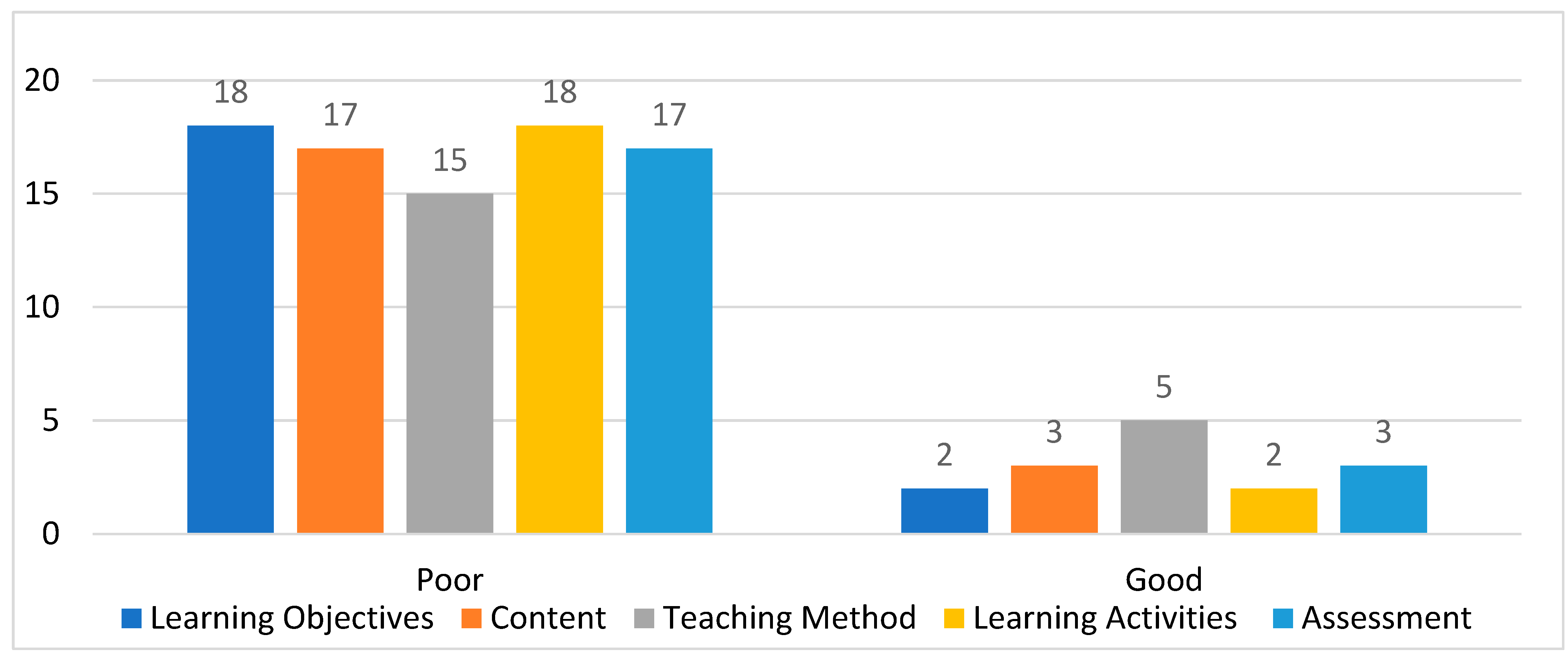

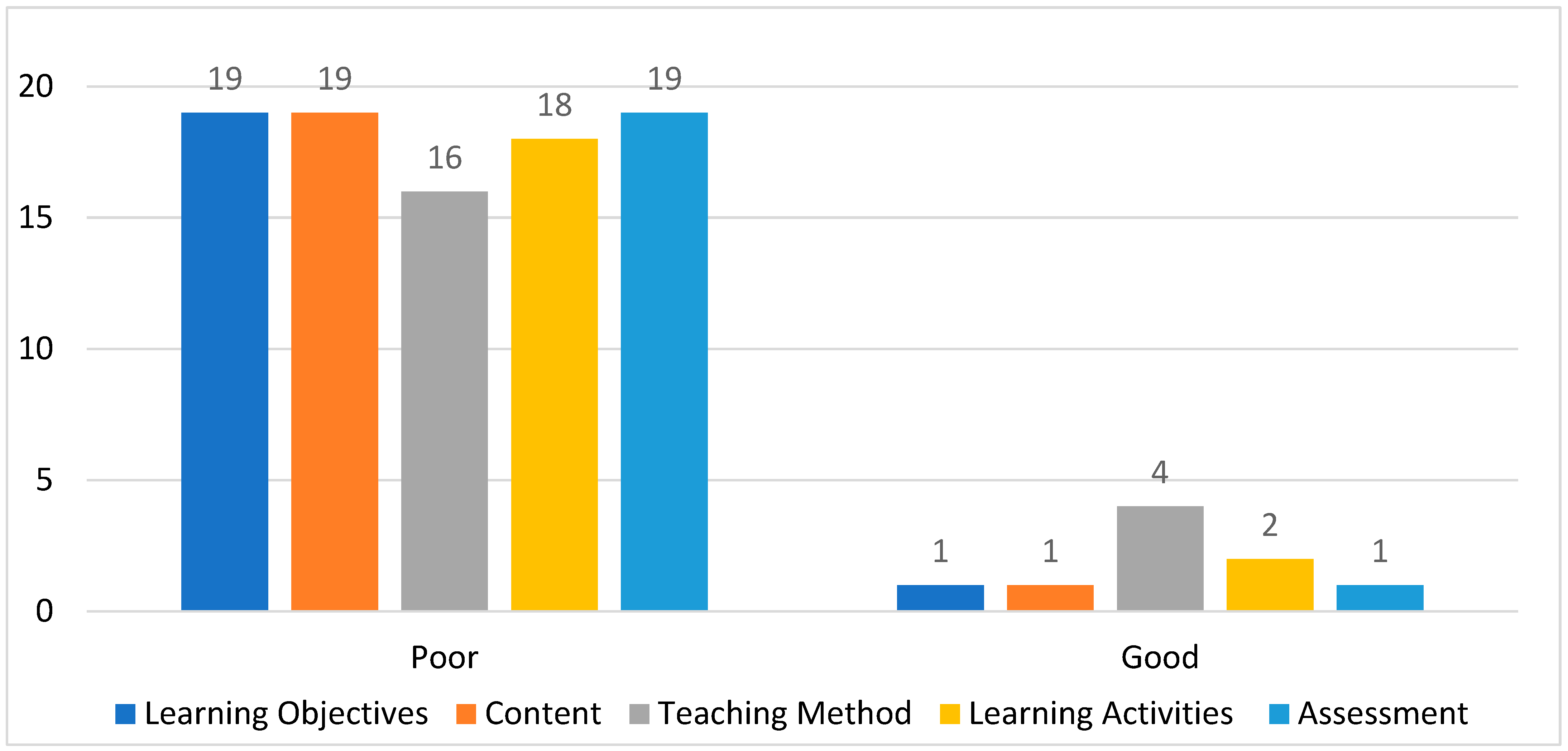

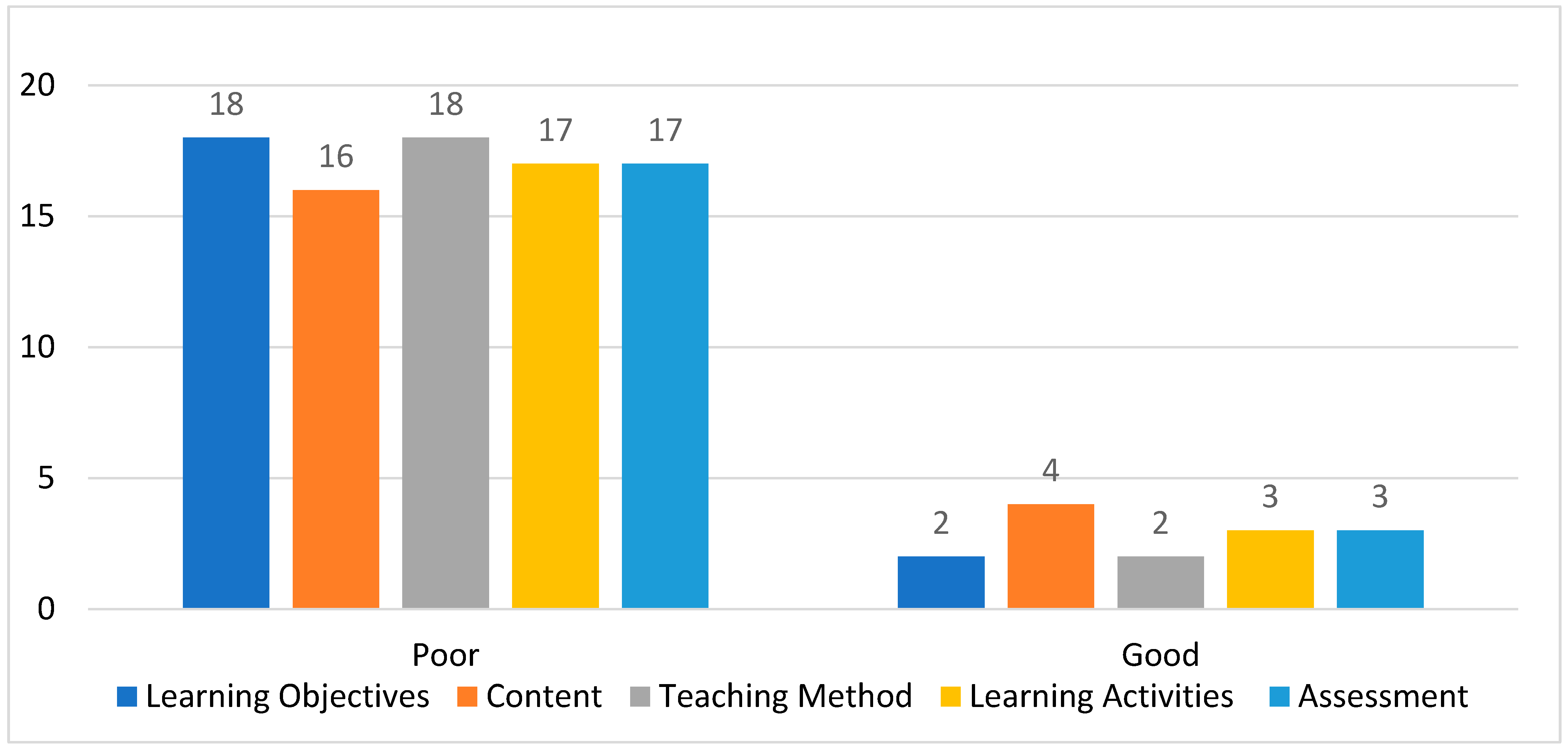


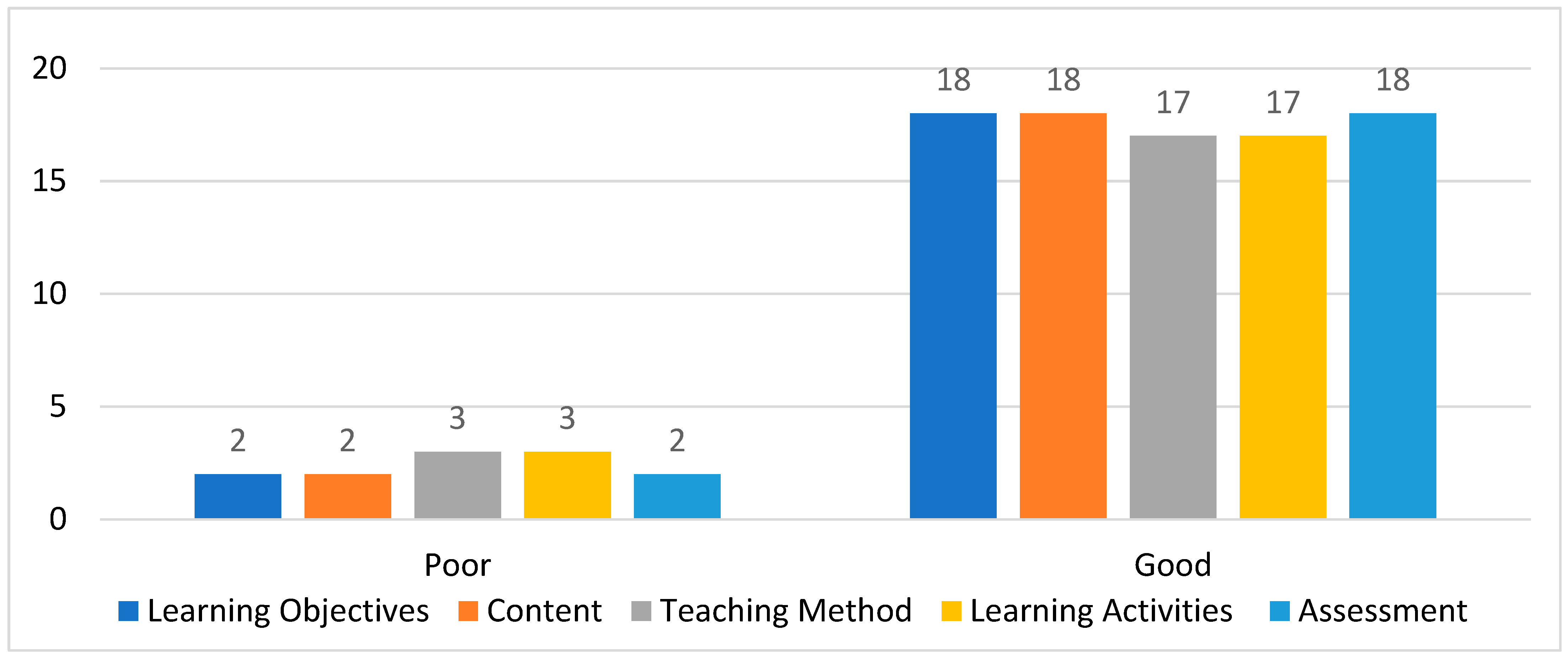


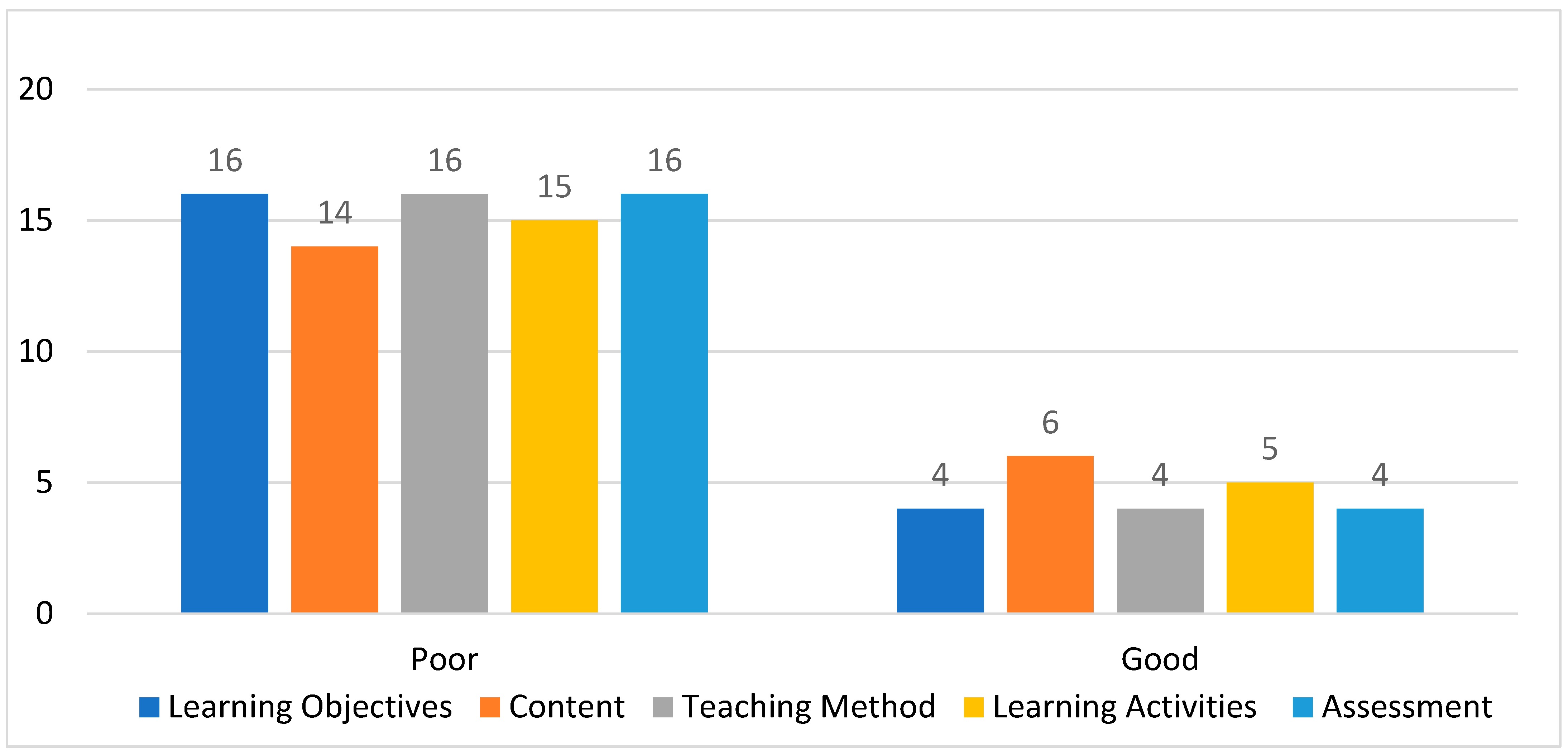
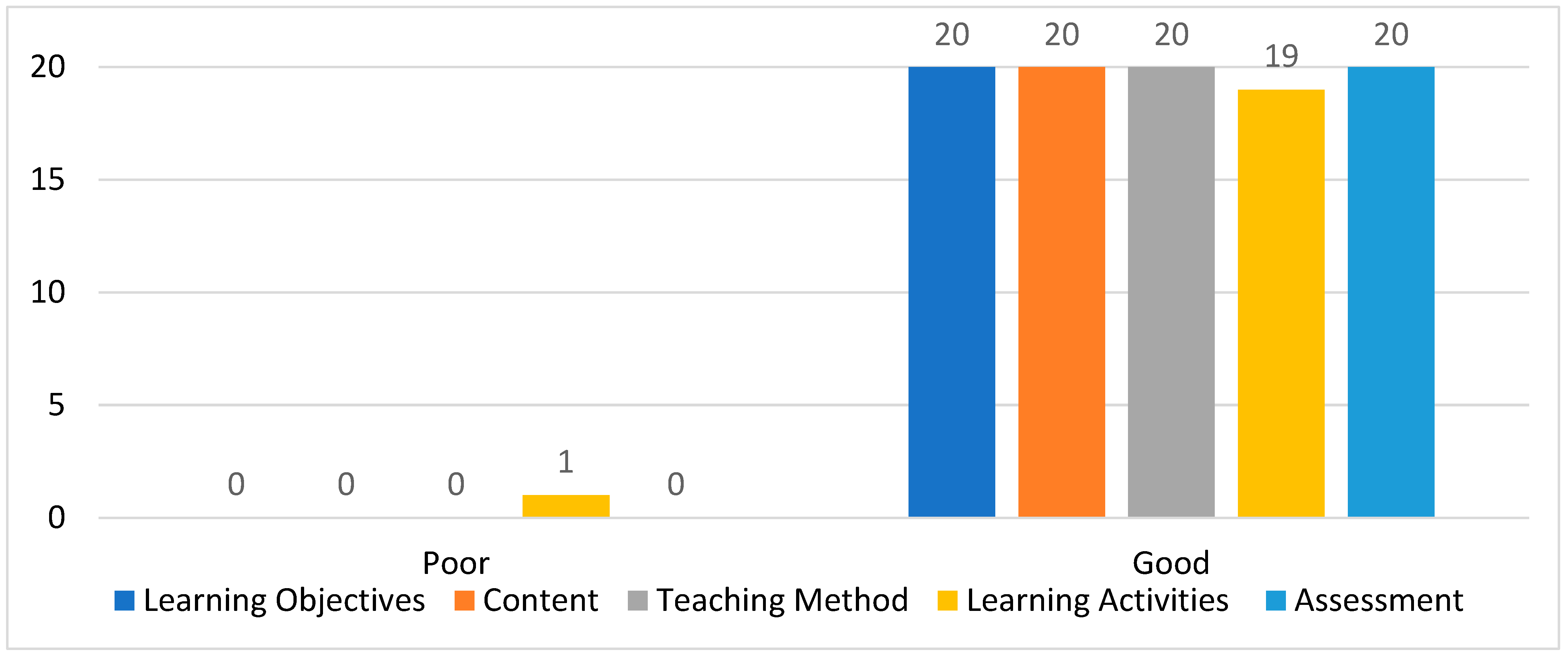

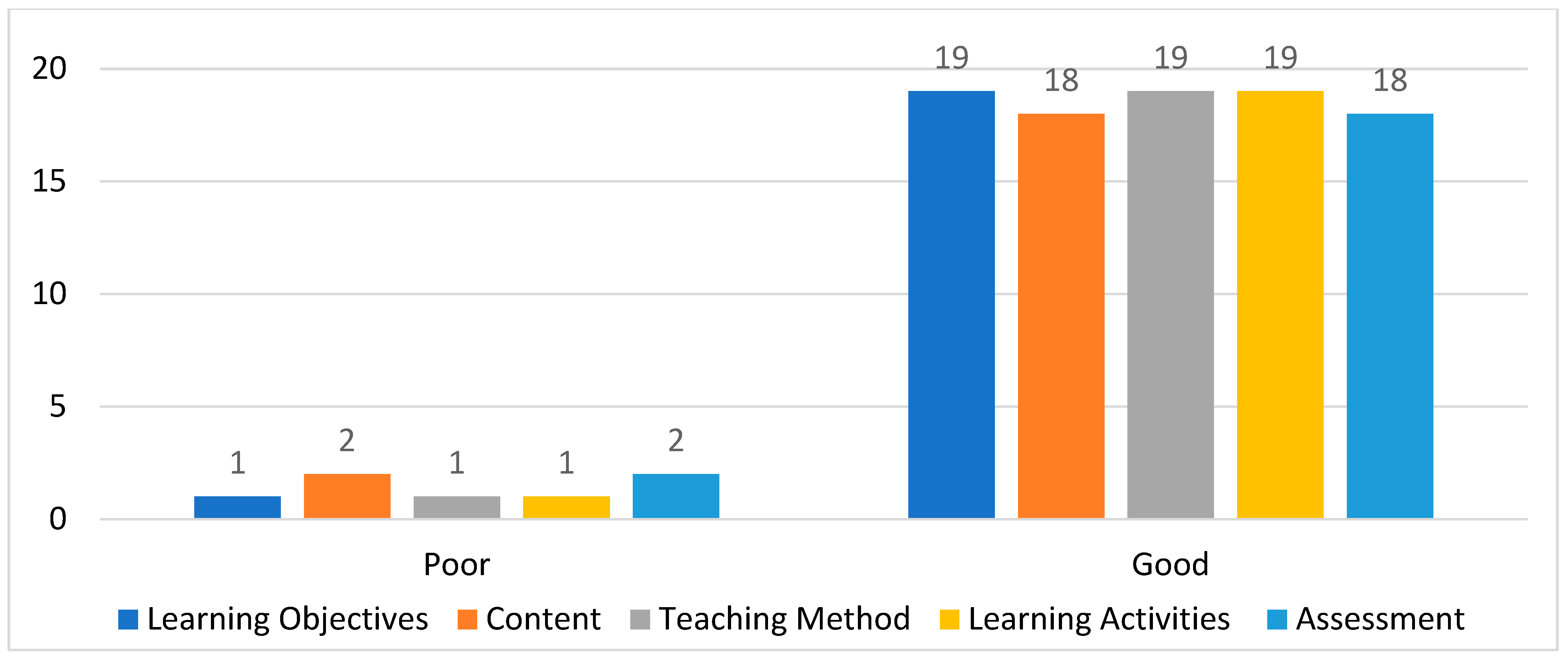


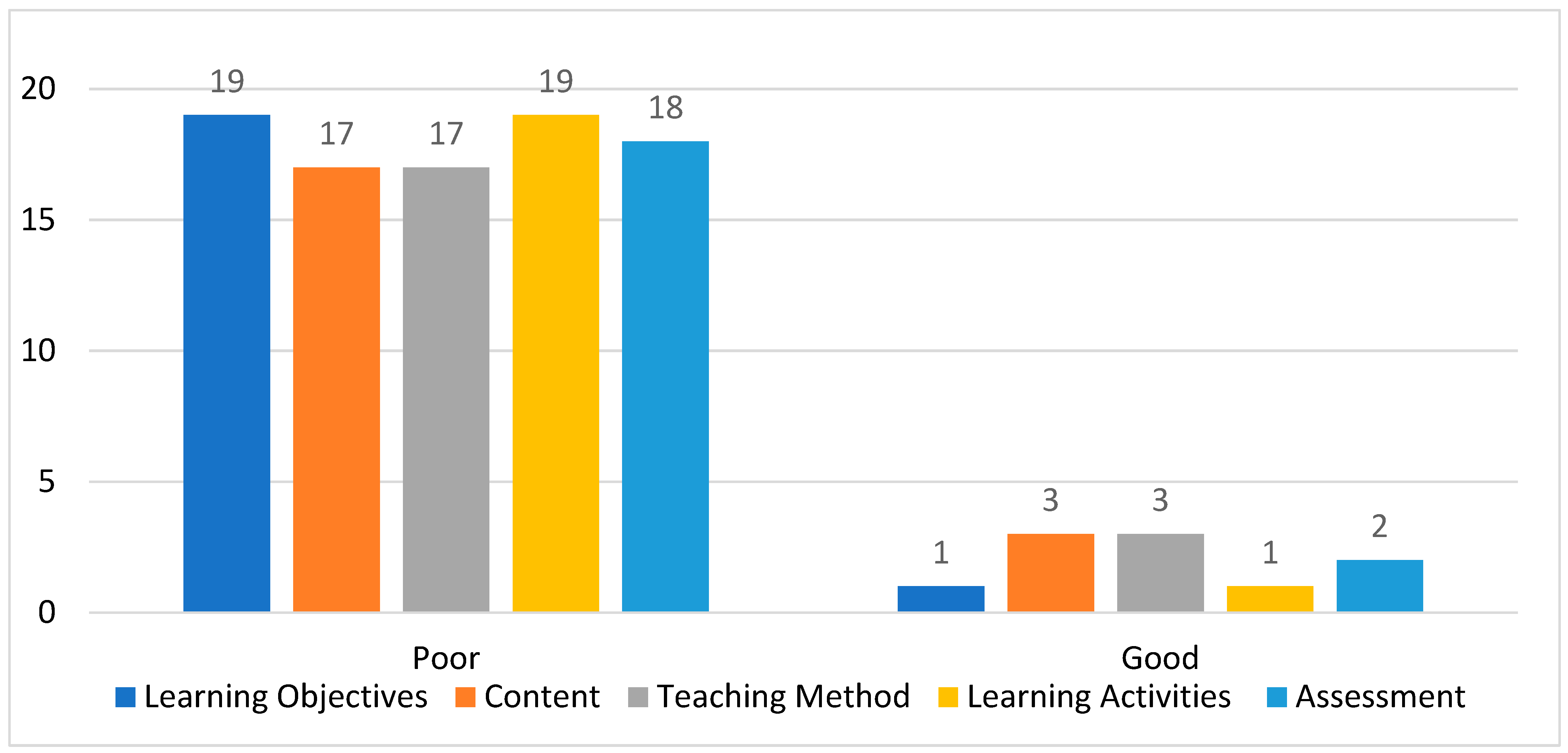

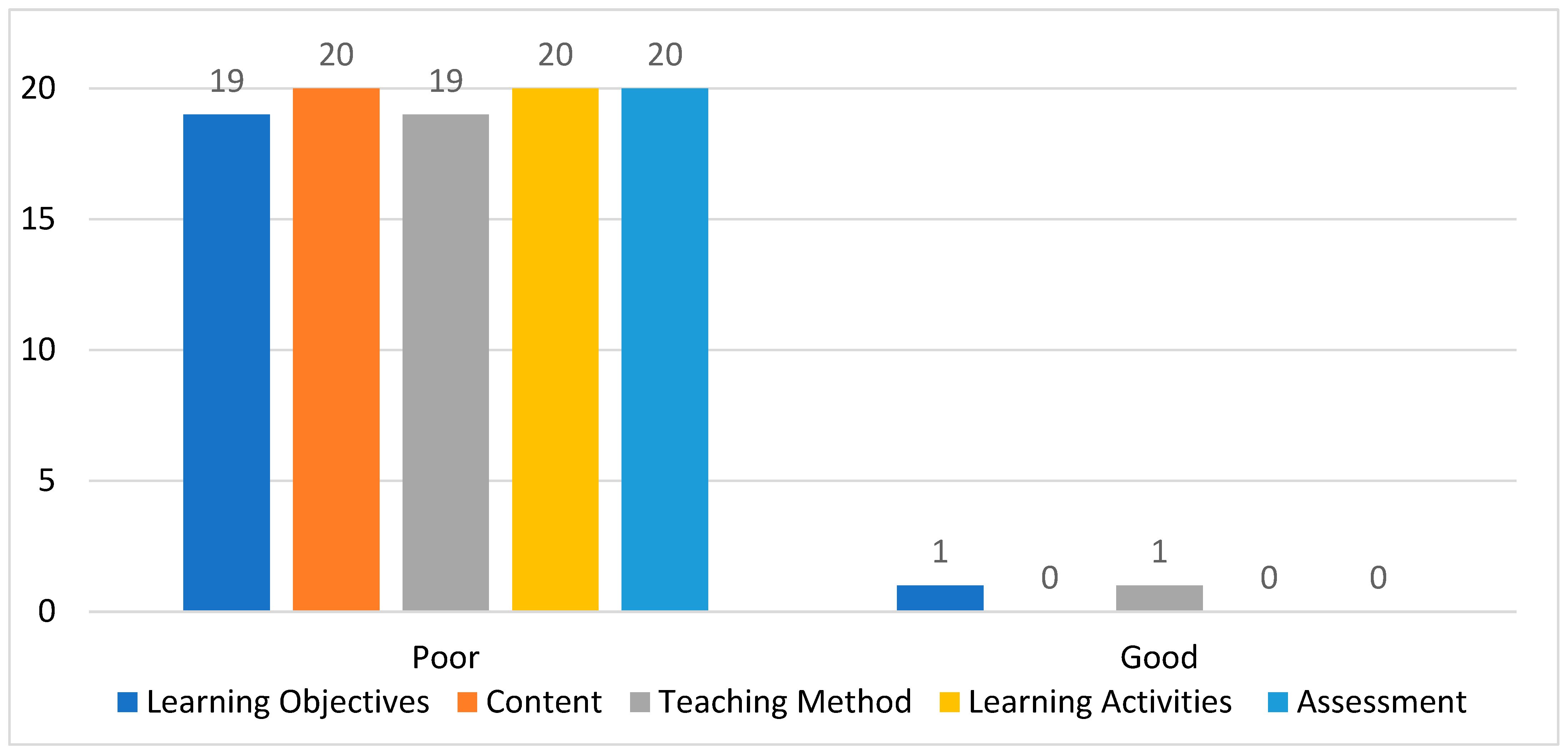





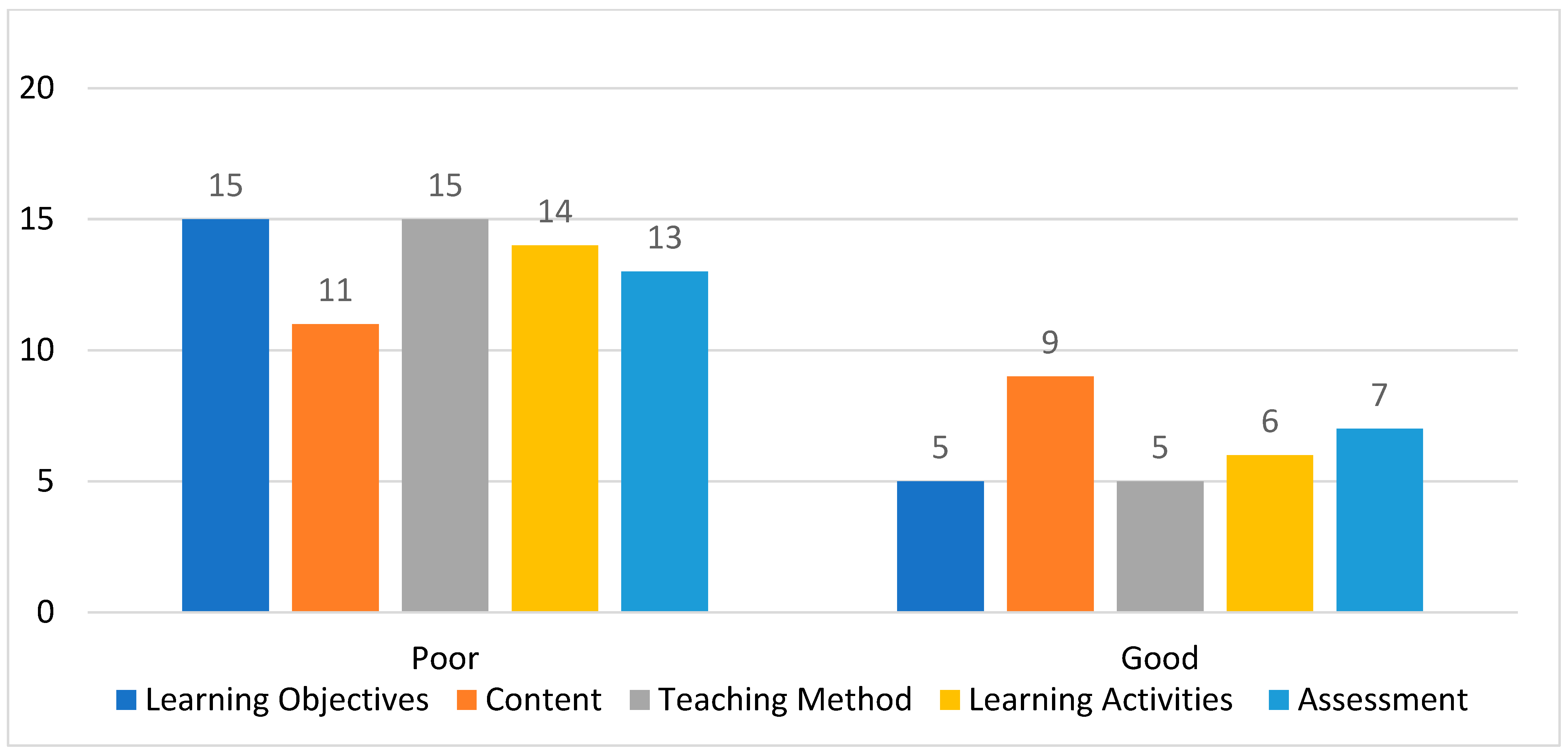
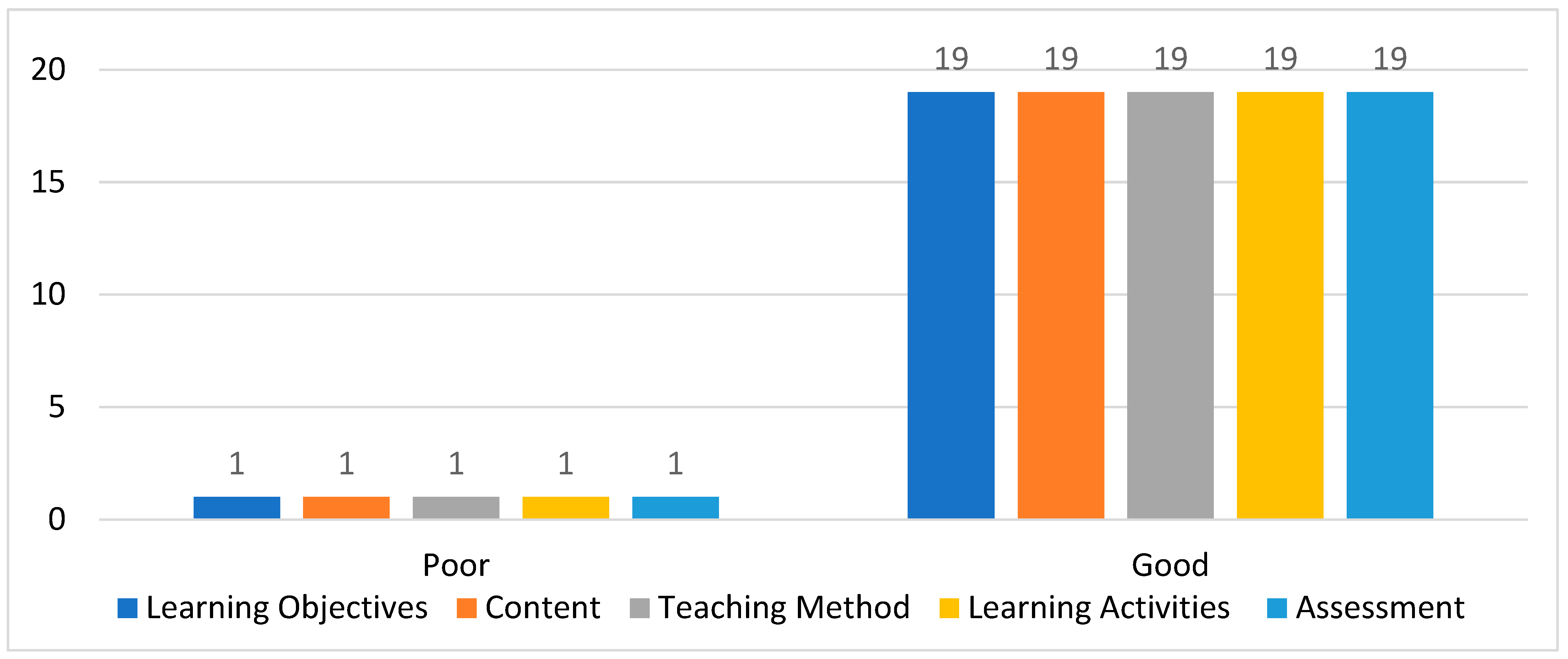
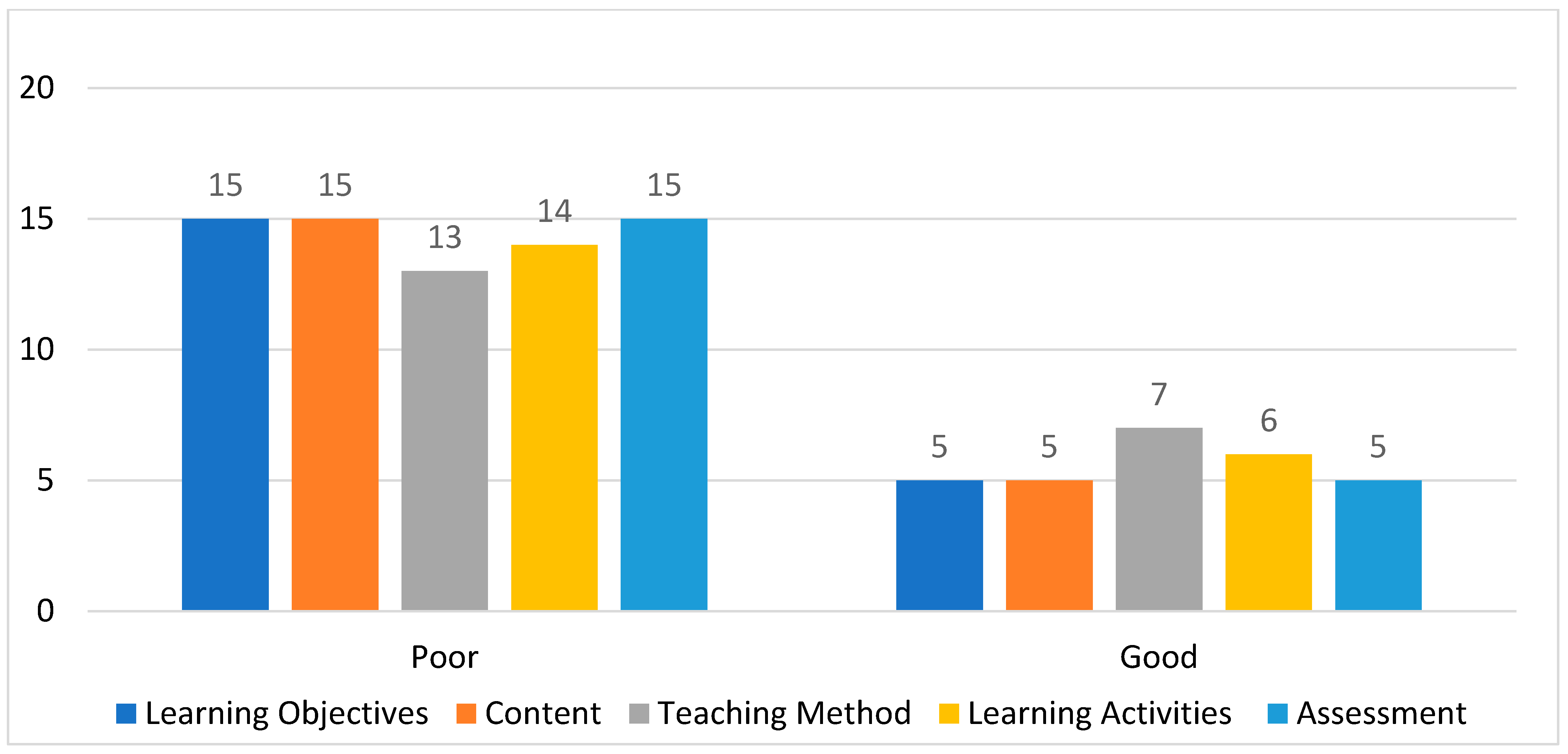
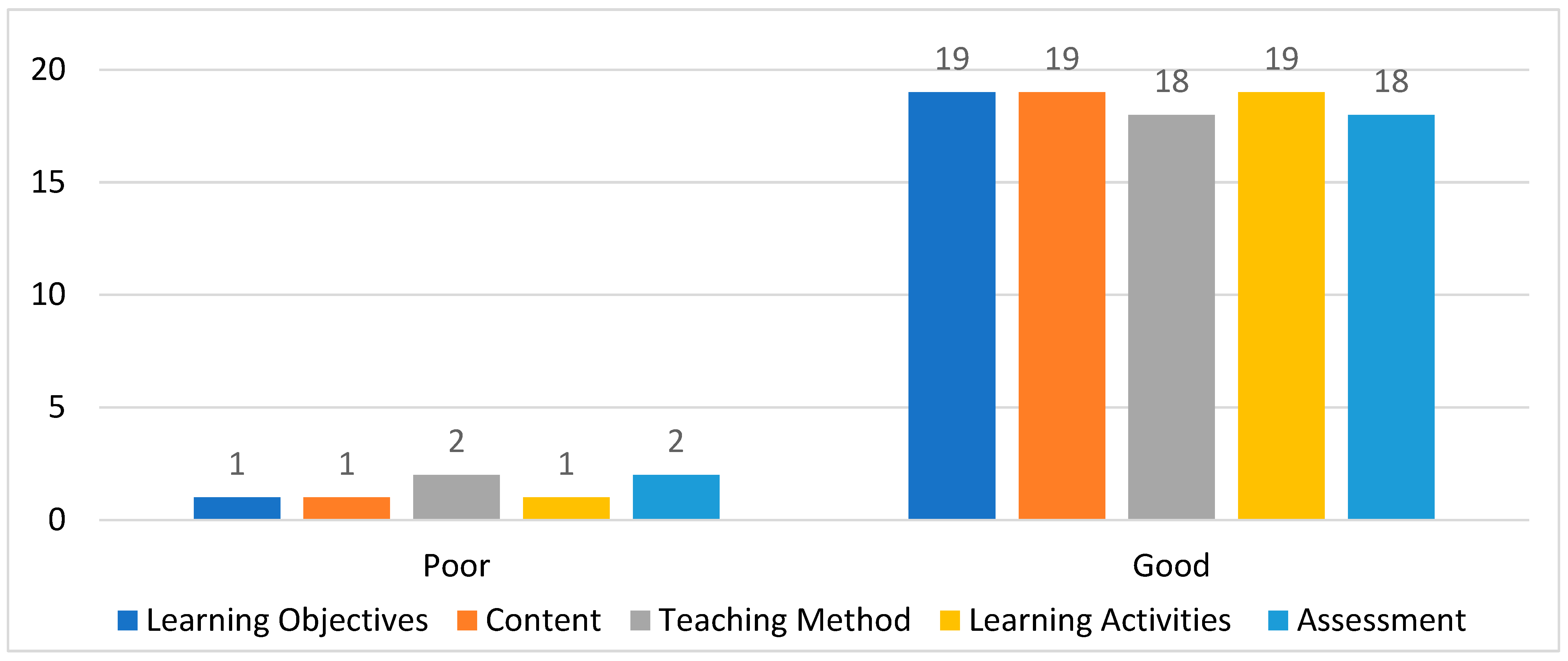

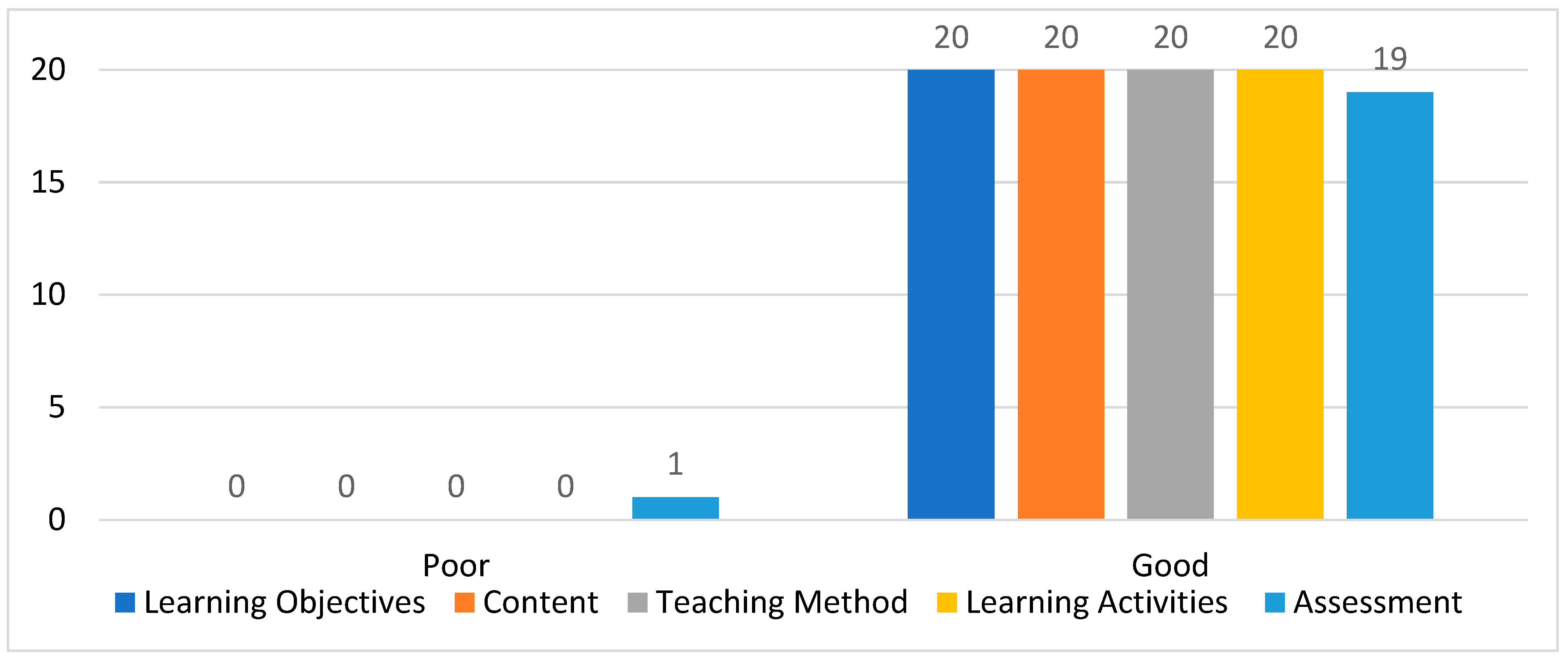
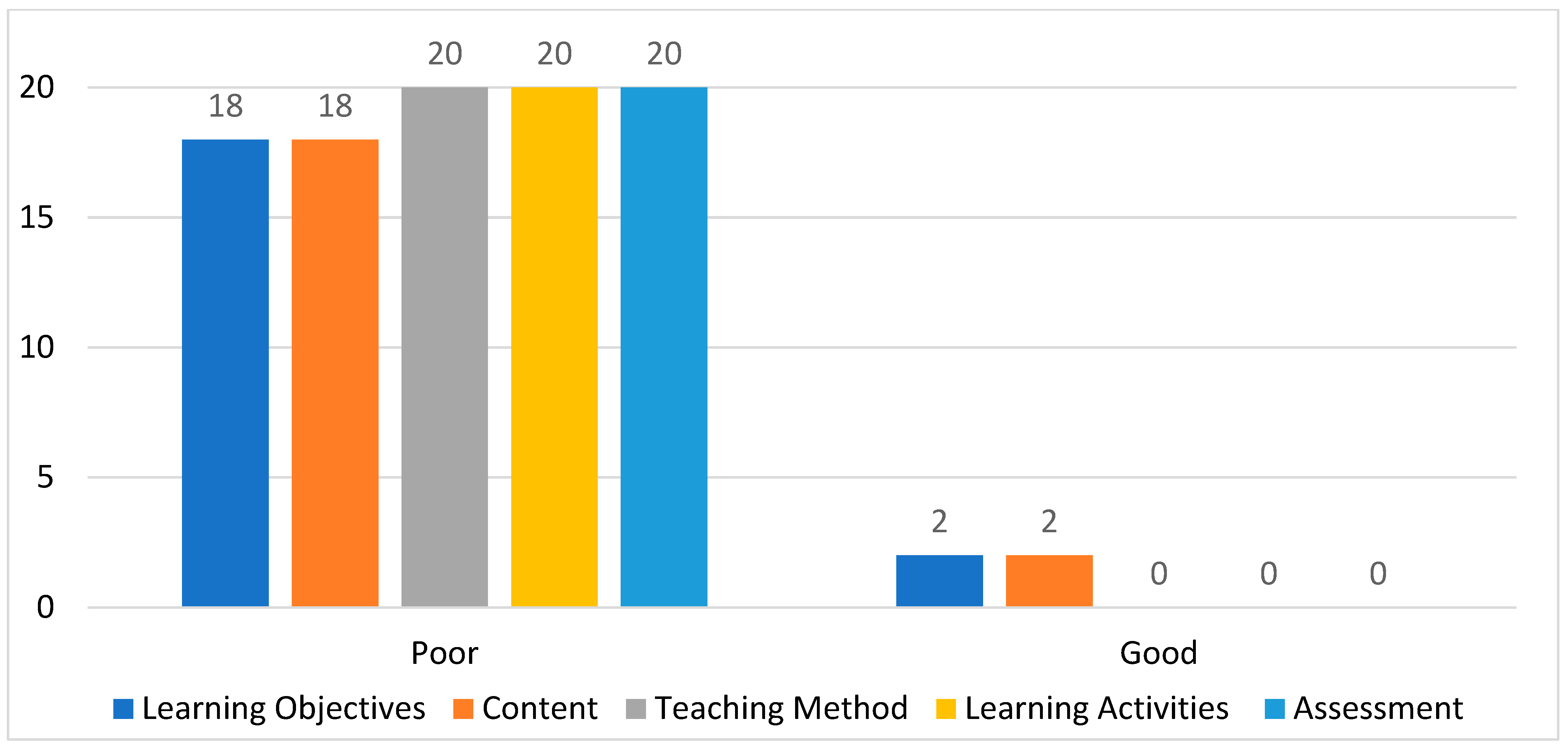

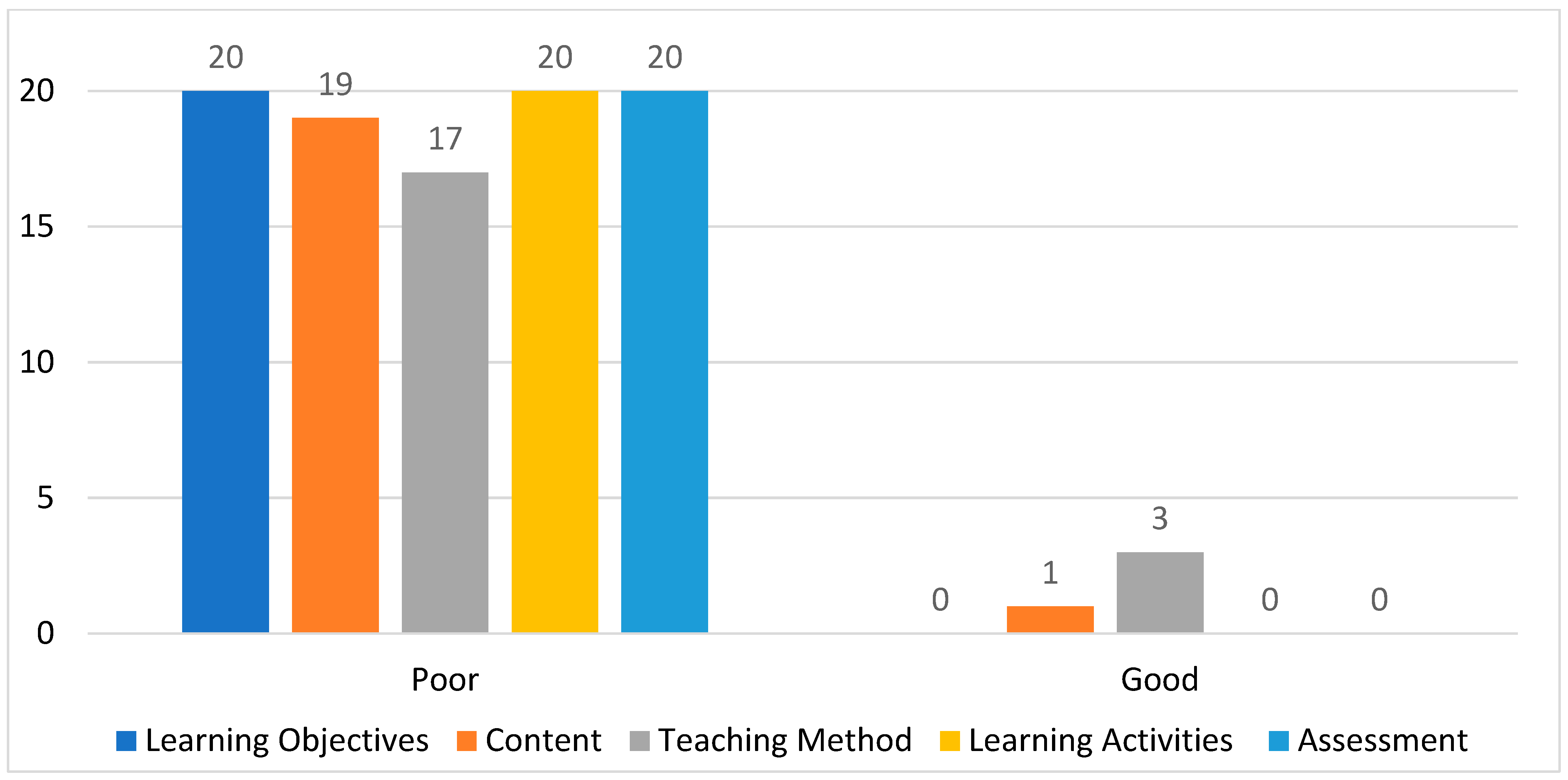
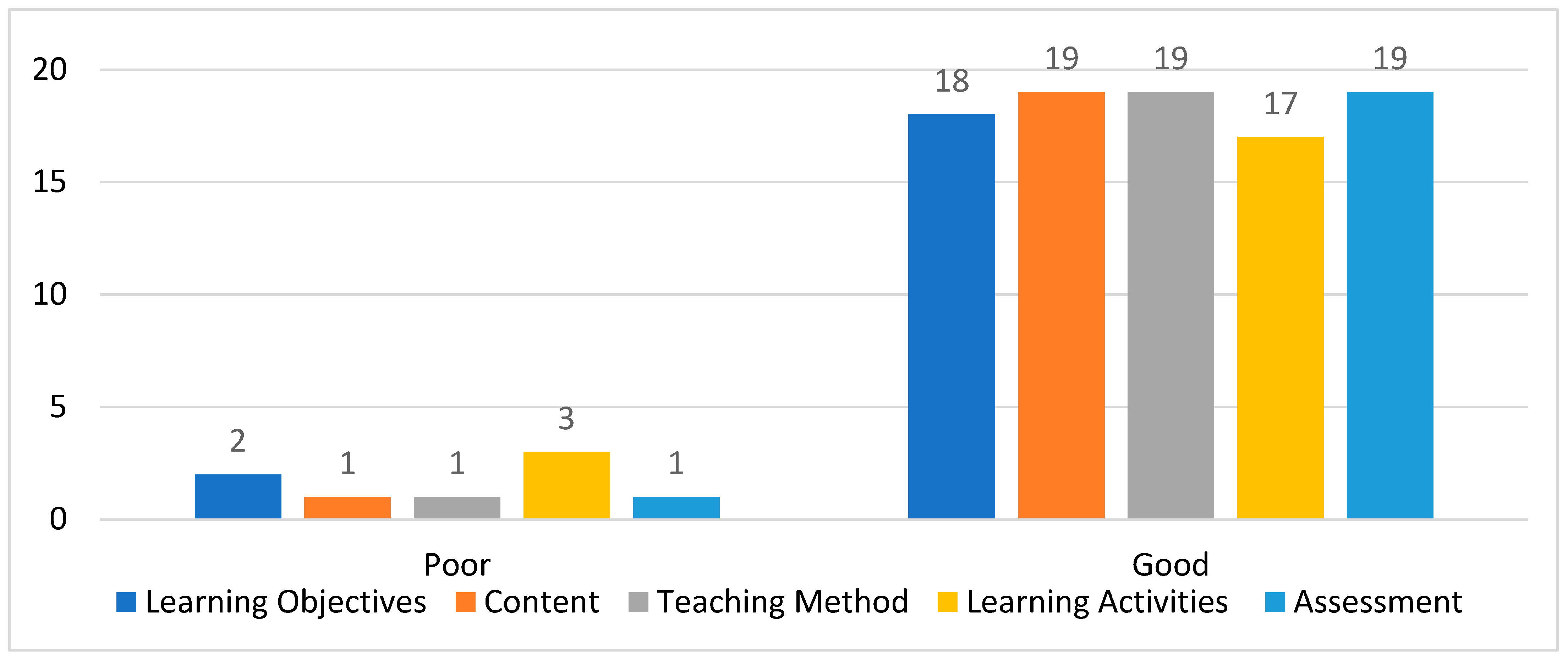

| Week | ‘Sustainable Ecology’ Course |
|---|---|
| Week 1 | Data collection: Semi-structured interviews |
| Week 2 (2 lesson hours) | Theoretical Information about SDG1 + SDG2 Education for SDG 1 + SDG 2 (teaching approaches and methods) Resources from https://www.unesco.org/en/sustainable-development/education (accessed on 10 September 2025) |
| Week 3 (2 lesson hours) | Theoretical Information about SDG3 + SDG4 Education for SDG3 + SDG4 (teaching approaches and methods) Resources from https://www.unesco.org/en/sustainable-development/education (accessed on 10 September 2025) |
| Week 4 (2 lesson hours) | Theoretical Information about SDG5 + SDG6 Education for SDG5 + SDG6 (teaching approaches and methods) Resources from https://www.unesco.org/en/sustainable-development/education (accessed on 10 September 2025) |
| Week 5 (2 lesson hours) | Theoretical Information about SDG7 + SDG8 Education for SDG7 + SDG8 (teaching approaches and methods) Resources from https://www.unesco.org/en/sustainable-development/education (accessed on 10 September 2025) |
| Week 6 (2 lesson hours) | Theoretical Information about SDG9 + SDG10 Education for SDG9 + SDG10 (teaching approaches and methods) Resources from https://www.unesco.org/en/sustainable-development/education (accessed on 10 September 2025) |
| Week 7 (2 lesson hours) | Theoretical Information about SDG11 + SDG12 Education for SDG SDG11 + SDG12 (teaching approaches and methods) Resources from https://www.unesco.org/en/sustainable-development/education (accessed on 10 September 2025) |
| Week 8 (2 lesson hours) | Theoretical Information about SDG13 + SDG14 Education for SDG13 + SDG14 (teaching approaches and methods) Resources from https://www.unesco.org/en/sustainable-development/education (accessed on 10 September 2025) |
| Week 9 (2 lesson hours) | Theoretical Information about SDG15 + SDG16 Education for SDG15 + SDG16 (teaching approaches and methods) Resources from https://www.unesco.org/en/sustainable-development/education (accessed on 10 September 2025) |
| Week 10 (2 lesson hours) | Theoretical Information about SDG17 Education for SDG17 (teaching approaches and methods) Resources from https://www.unesco.org/en/sustainable-development/education (accessed on 10 September 2025) |
| Week 11 (2 lesson hours) | Preparing lesson plans for SDGs + presentation of lesson plans |
| Week 12 | Data collection: Semi-structured interviews |
Disclaimer/Publisher’s Note: The statements, opinions and data contained in all publications are solely those of the individual author(s) and contributor(s) and not of MDPI and/or the editor(s). MDPI and/or the editor(s) disclaim responsibility for any injury to people or property resulting from any ideas, methods, instructions or products referred to in the content. |
© 2025 by the author. Licensee MDPI, Basel, Switzerland. This article is an open access article distributed under the terms and conditions of the Creative Commons Attribution (CC BY) license (https://creativecommons.org/licenses/by/4.0/).
Share and Cite
Koçulu, A. Preparing Future Science Teachers to Build a Sustainable World: Supporting Pre-Service Science Teachers’ Competencies in Instructional Planning for Teaching the Sustainable Development Goals (SDGs) in K-12 Classrooms. Sustainability 2025, 17, 10427. https://doi.org/10.3390/su172210427
Koçulu A. Preparing Future Science Teachers to Build a Sustainable World: Supporting Pre-Service Science Teachers’ Competencies in Instructional Planning for Teaching the Sustainable Development Goals (SDGs) in K-12 Classrooms. Sustainability. 2025; 17(22):10427. https://doi.org/10.3390/su172210427
Chicago/Turabian StyleKoçulu, Aslı. 2025. "Preparing Future Science Teachers to Build a Sustainable World: Supporting Pre-Service Science Teachers’ Competencies in Instructional Planning for Teaching the Sustainable Development Goals (SDGs) in K-12 Classrooms" Sustainability 17, no. 22: 10427. https://doi.org/10.3390/su172210427
APA StyleKoçulu, A. (2025). Preparing Future Science Teachers to Build a Sustainable World: Supporting Pre-Service Science Teachers’ Competencies in Instructional Planning for Teaching the Sustainable Development Goals (SDGs) in K-12 Classrooms. Sustainability, 17(22), 10427. https://doi.org/10.3390/su172210427








